The previous sequel of my stories about the trip around the Peloponnese in September 2023 ended with a photograph from January 2013, when I first visited the medieval town of Mystras. At that time, a rainbow appeared and I always fall for that, so I decided to start this continuation with a similar photo featuring not only the rainbow, but also the Church of Saint Demetrius that was once the city's cathedral.
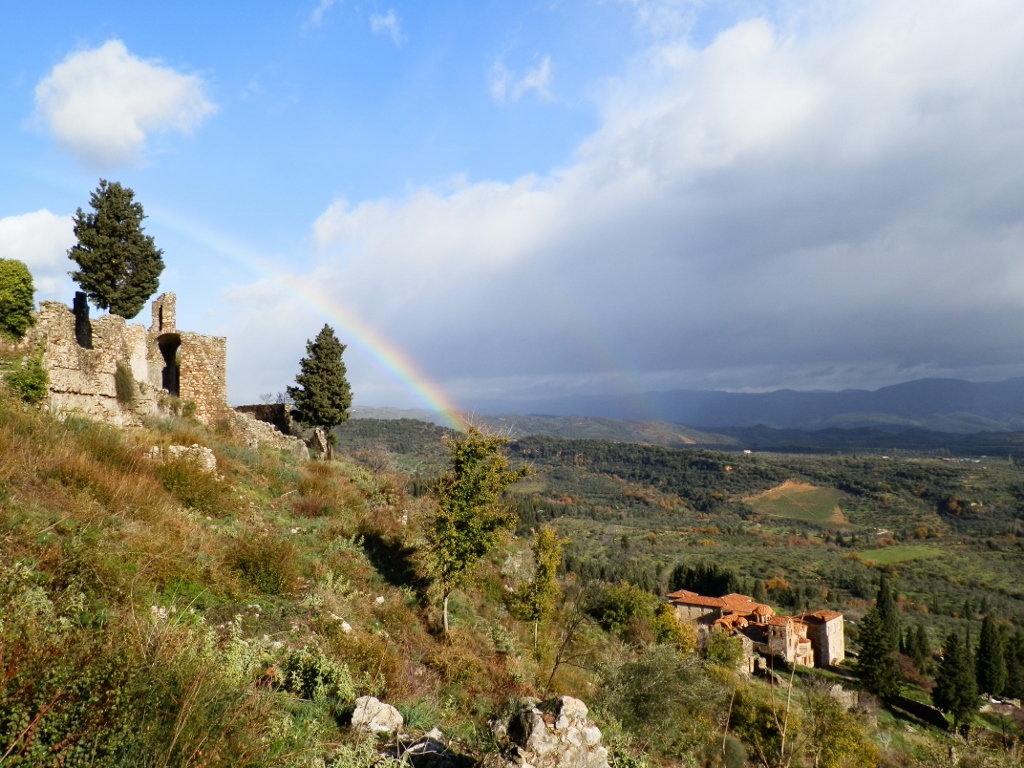 Church of Saint Demetrius (2013)
Church of Saint Demetrius (2013)
With its magnificent location and undeniable significance, Mystras functioned from its founding in the 13th century until the 19th century, when modern Sparta was established, leading the residents of this town to move gradually to the flatter regions. I completely understand them – it wasn't easy for me as an ordinary visitor to keep climbing up and down.
Since I have already written a bit about Mystras and its history in the previous sequel, I won’t repeat it here, but I would like to mention that this site is inscribed on the UNESCO’s World Heritage List. Visiting the most important monuments that can still be seen today allows visitors to gain a very good understanding of various aspects of Byzantine culture, as the Byzantine churches and monasteries are the most significant structures here, with one of them still active today. This is the Pantanassa Monastery, founded in 1428, which is one of the most important monuments on the entire site. The monastery is dedicated to the Virgin Mary, while "Pantanasa" in Greek means "Queen of All" and this is one of the traditional epithets for the Virgin Mary within Greek Orthodoxy.
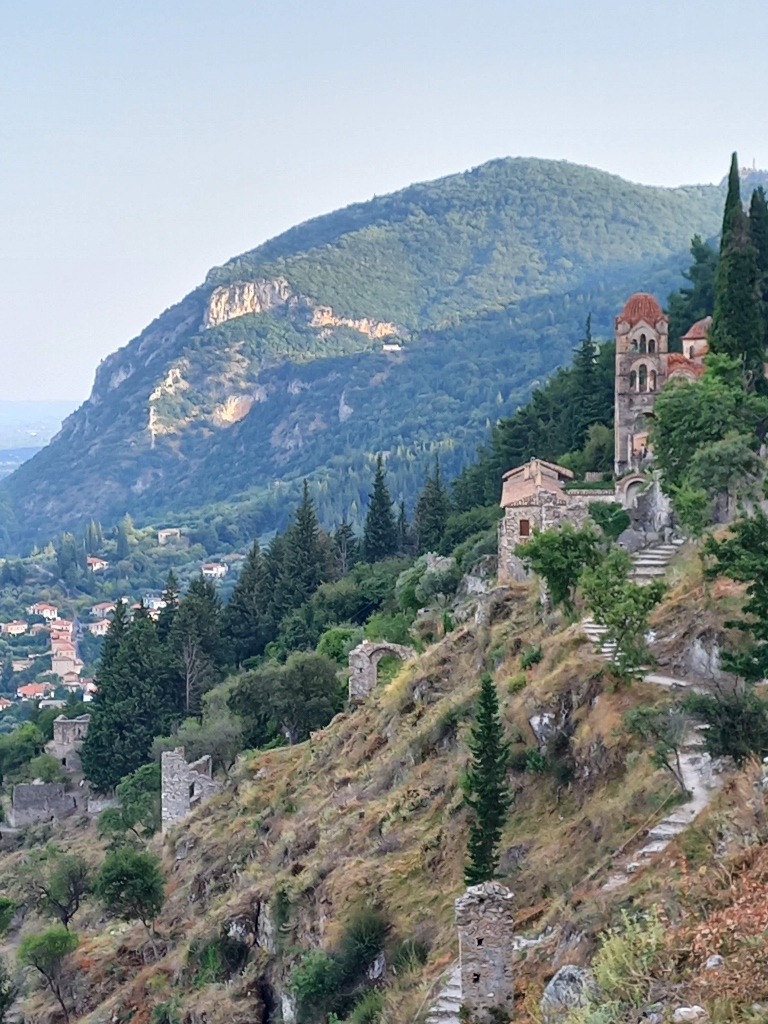 Pantanassa Monastery
Pantanassa Monastery
Interestingly, during the early Christian period, monasteries were founded outside urban settlements. It was believed that monks should live away from the "noise of the city" and its temptations. However, starting in the 6th century, monasteries began to be established within cities themselves, while attitudes shifted. Monks were now expected not only to resist temptations, but also to serve the community.
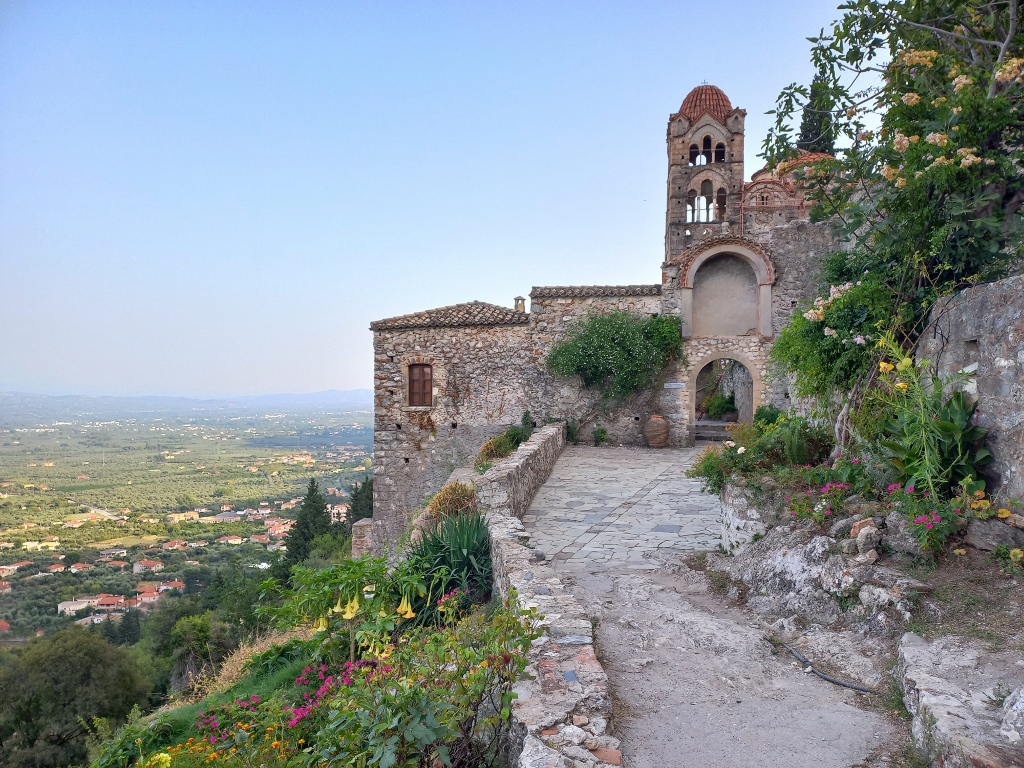 Pantanassa Monastery
Pantanassa Monastery
Monastic complexes typically featured a main church or katholikon at the centre of an area surrounded by walls (fortified enclosure), with other buildings constructed along these walls to meet the daily needs of the monks – such as a refectory, kitchen, baths, storage and so on.
An illustration of this can be seen in a photograph from 2013, showing the narrow yet long monastic courtyard. Since everything was built on a very steep slope, there simply wasn’t space for a different layout.
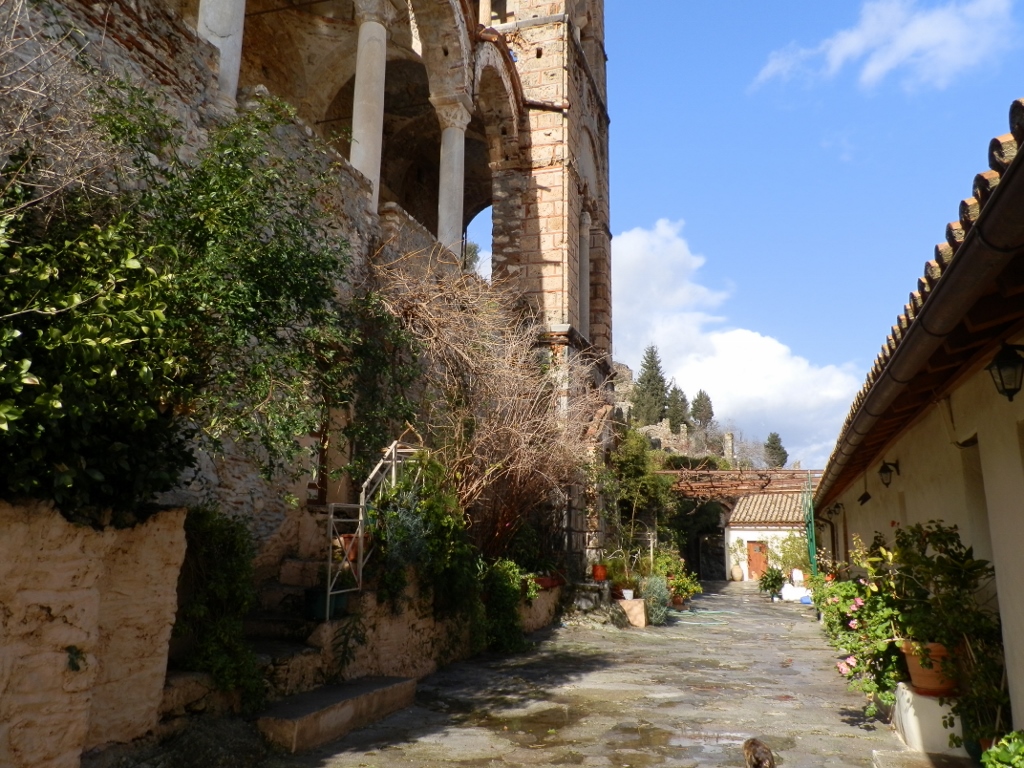 Pantanassa Monastery, a detail (2013)
Pantanassa Monastery, a detail (2013)
As for the monastic church, some parts date back to the 14th century, while the complete construction was finished in the early 15th century. From the outside, one of the most striking elements is the impressive Gothic bell tower, while on the eastern side, there is a portico with four arches.
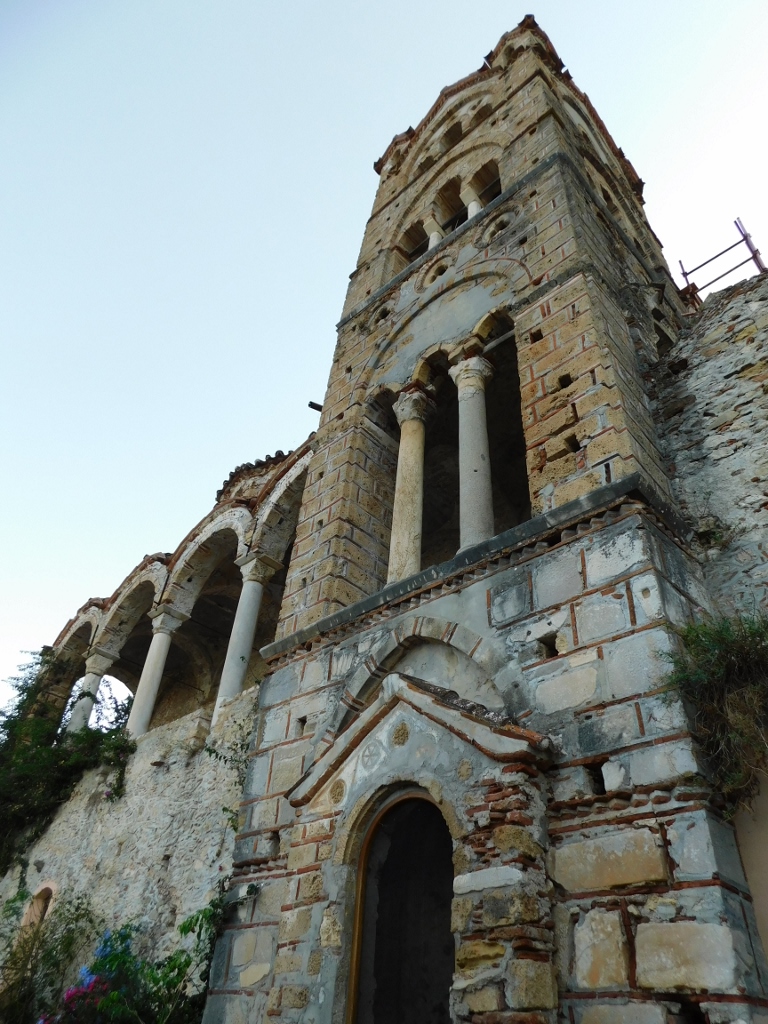 Pantanassa Monastery, a detail
Pantanassa Monastery, a detail
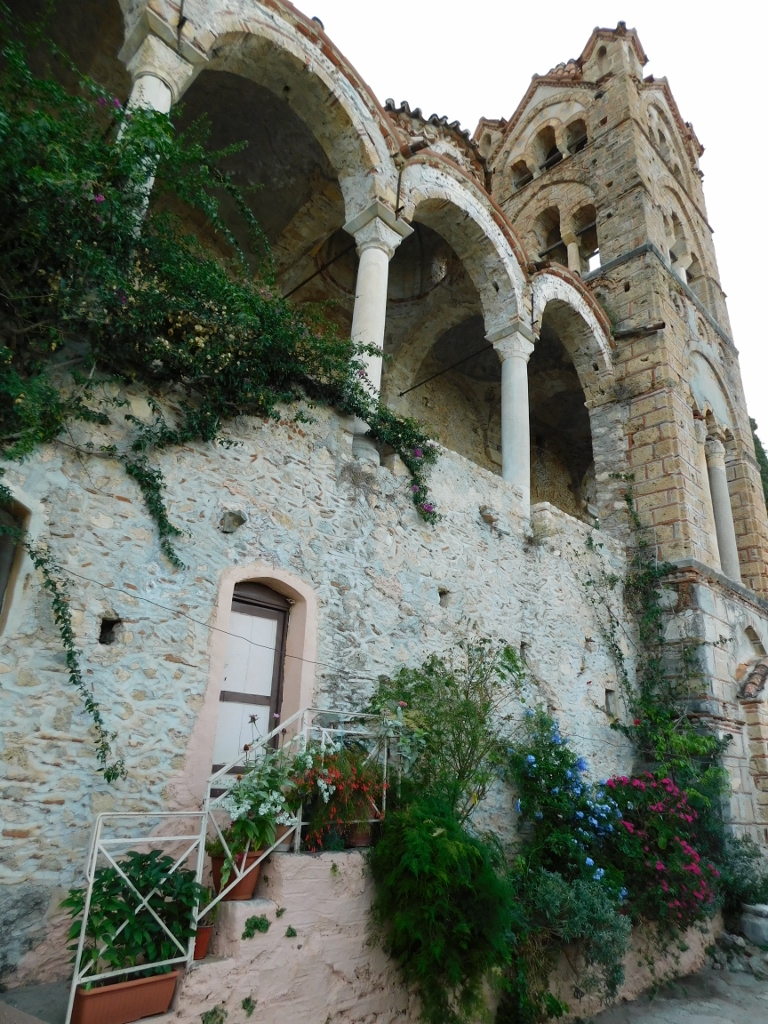 Pantanassa Monastery, a detail
Pantanassa Monastery, a detail
In order to visit the church, one needs to climb the steps at the front to reach the level of the portico, but it can also be done by accessing from the back, where there is a beautiful view of the southern facade featuring three semicircular apses.
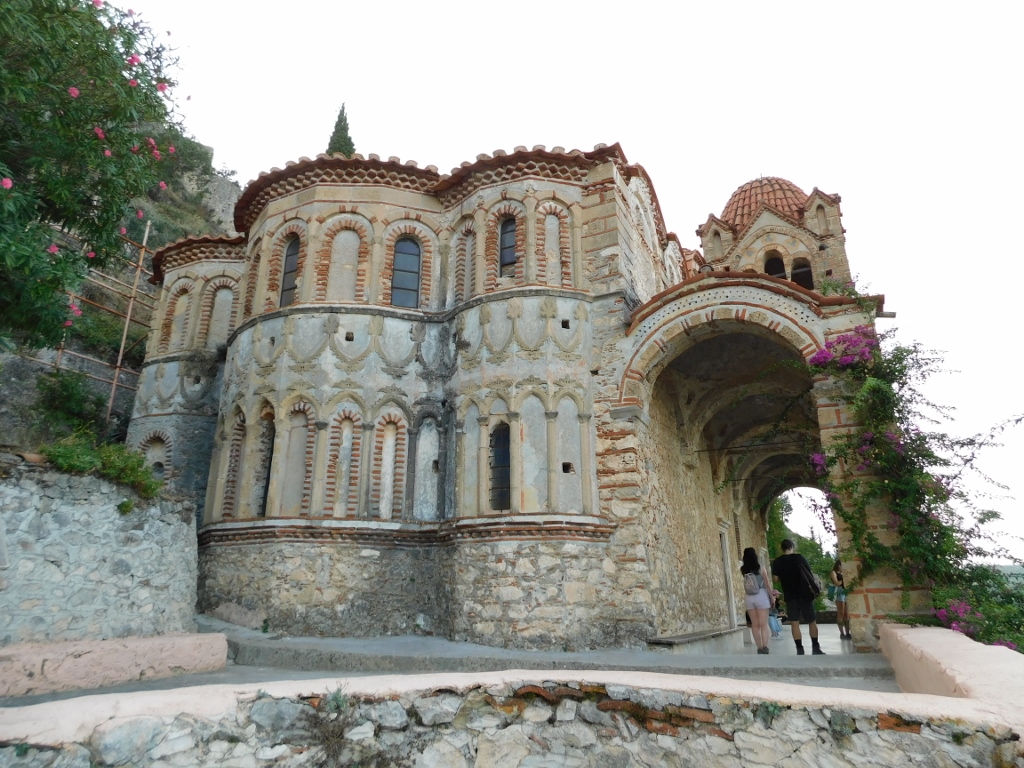 Pantanassa Monastery, a detail
Pantanassa Monastery, a detail
The absolutely stunning decoration of the facade is even more pronounced in a couple of photographs I took back in 2013, when the sun was shining on the church.
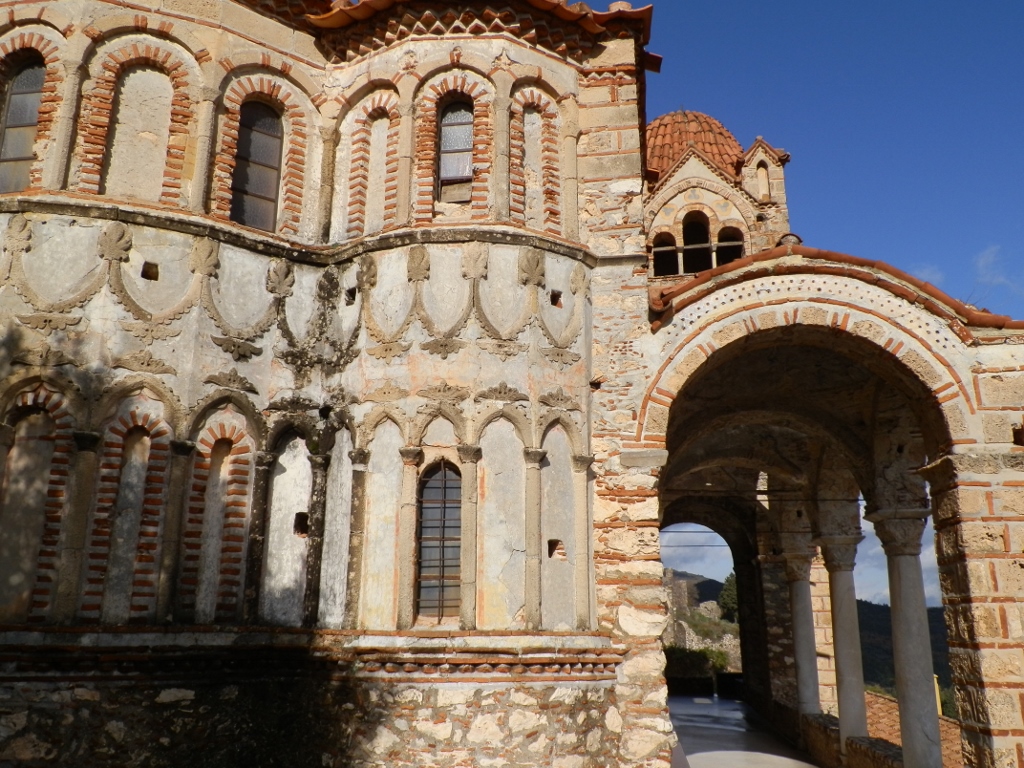 Pantanassa Monastery, a detail (2013)
Pantanassa Monastery, a detail (2013)
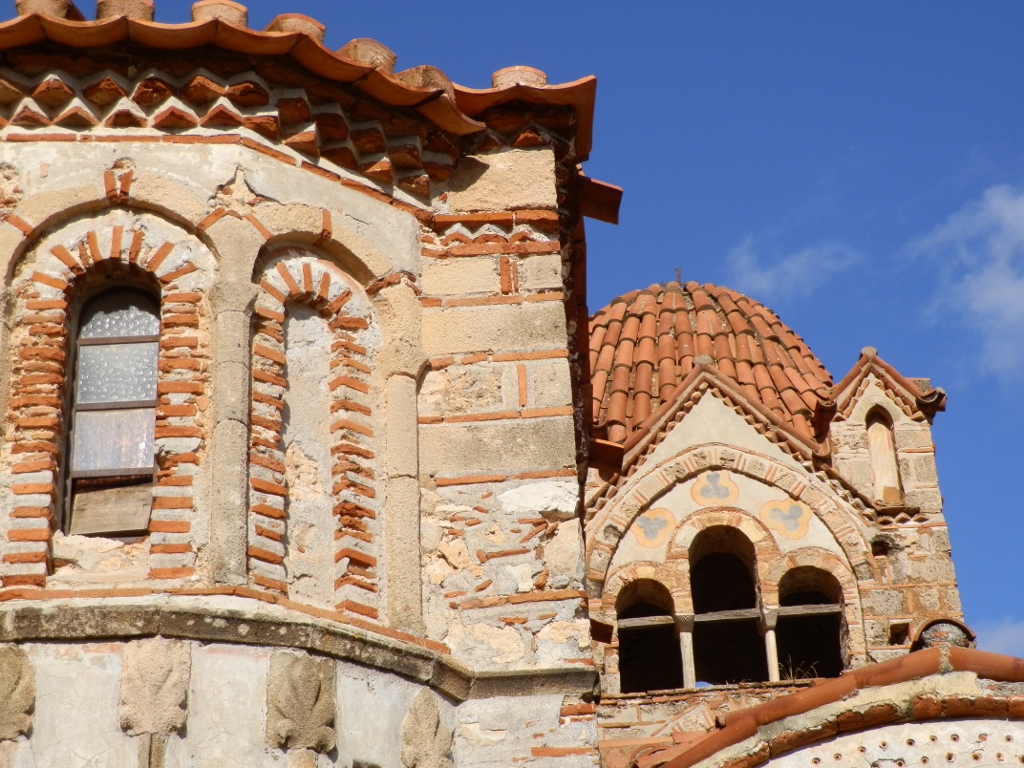 Pantanassa Monastery, a detail (2013)
Pantanassa Monastery, a detail (2013)
The frescoes date back to various periods, but from what I've read, the most successful ones are those from the 15th century. The impression upon entering the church is certainly striking.
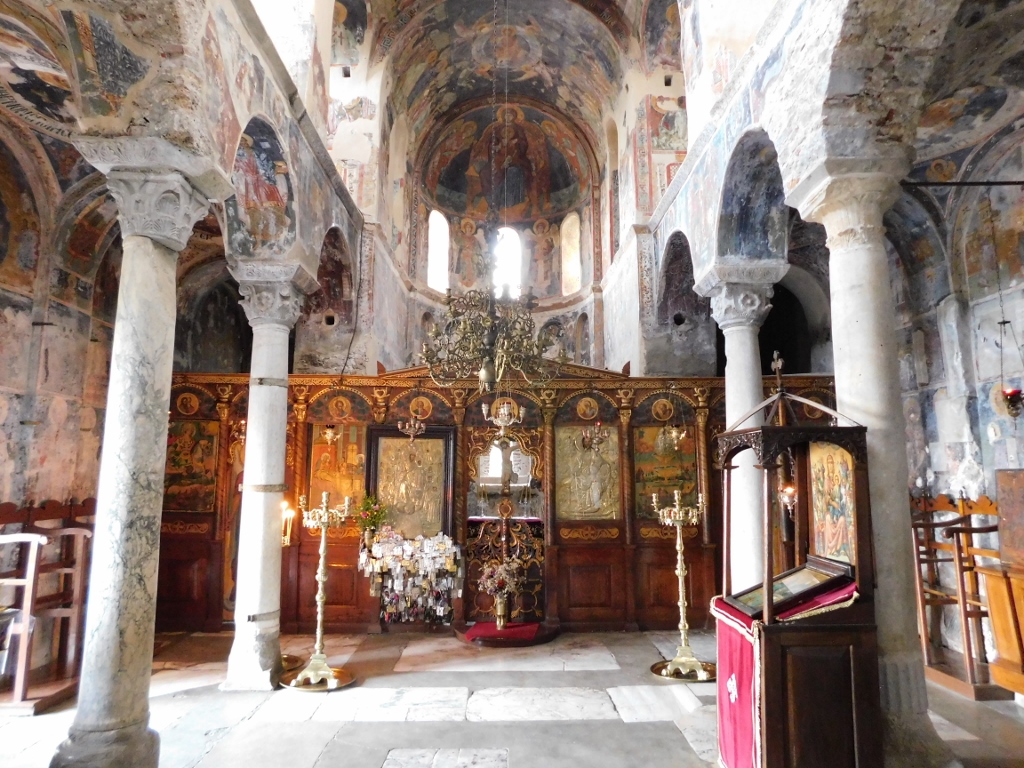 Pantanassa Monastery, a detail
Pantanassa Monastery, a detail
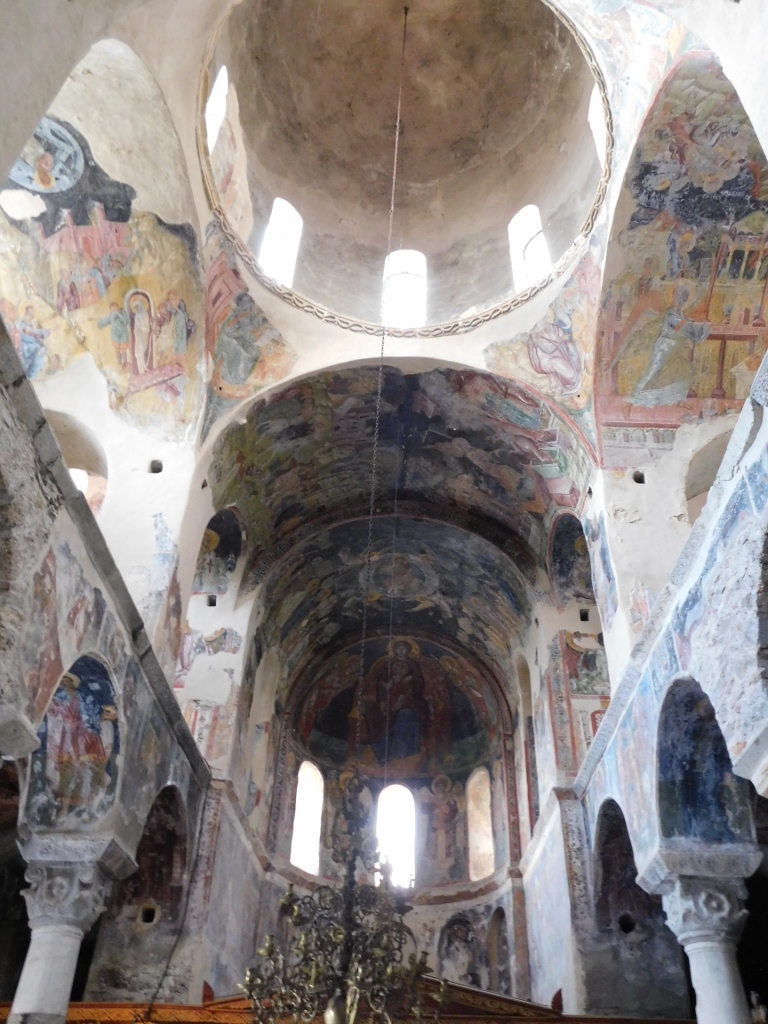 Pantanassa Monastery, a detail
Pantanassa Monastery, a detail
This church also features two foundations, which is a style typical for Mystras – the lower level is in the form of a three-aisled basilica, while the upper part has a cruciform layout. This is quite clearly visible in the next photograph.
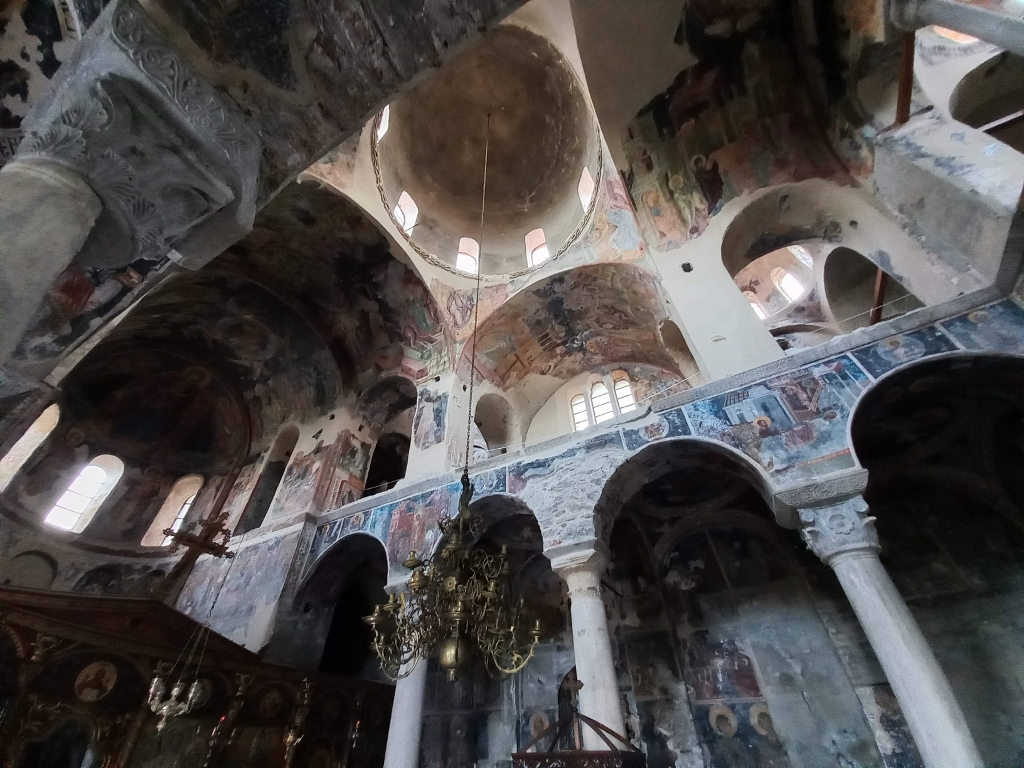 Pantanassa Monastery, a detail
Pantanassa Monastery, a detail
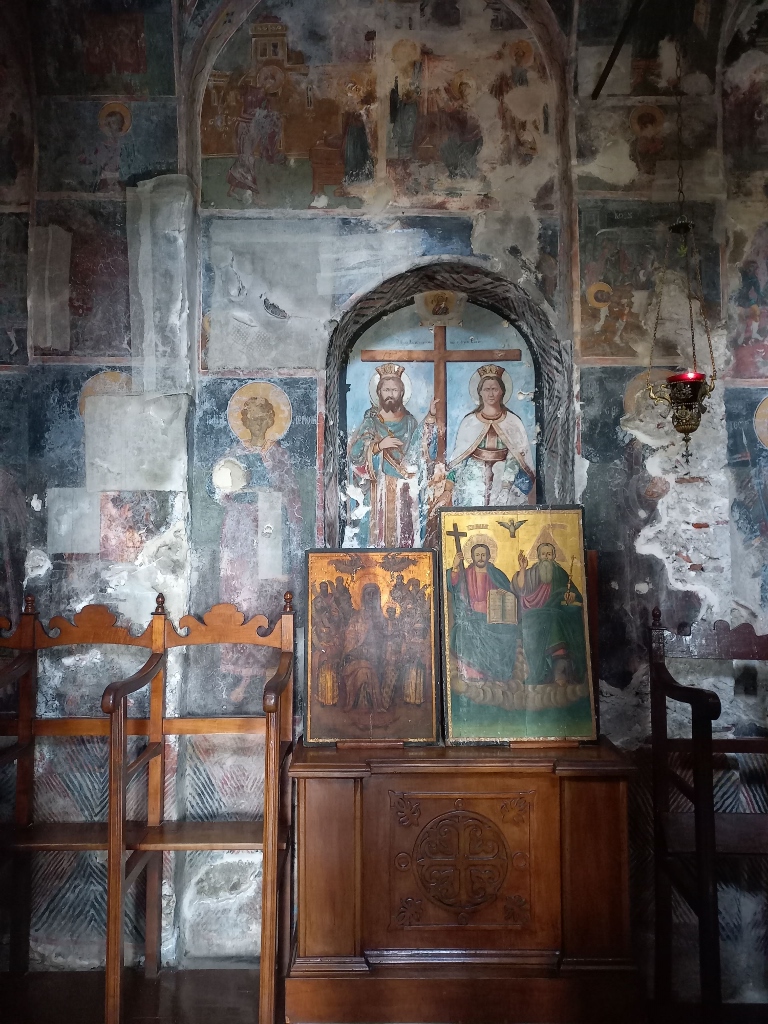 Pantanassa Monastery, a detail
Pantanassa Monastery, a detail
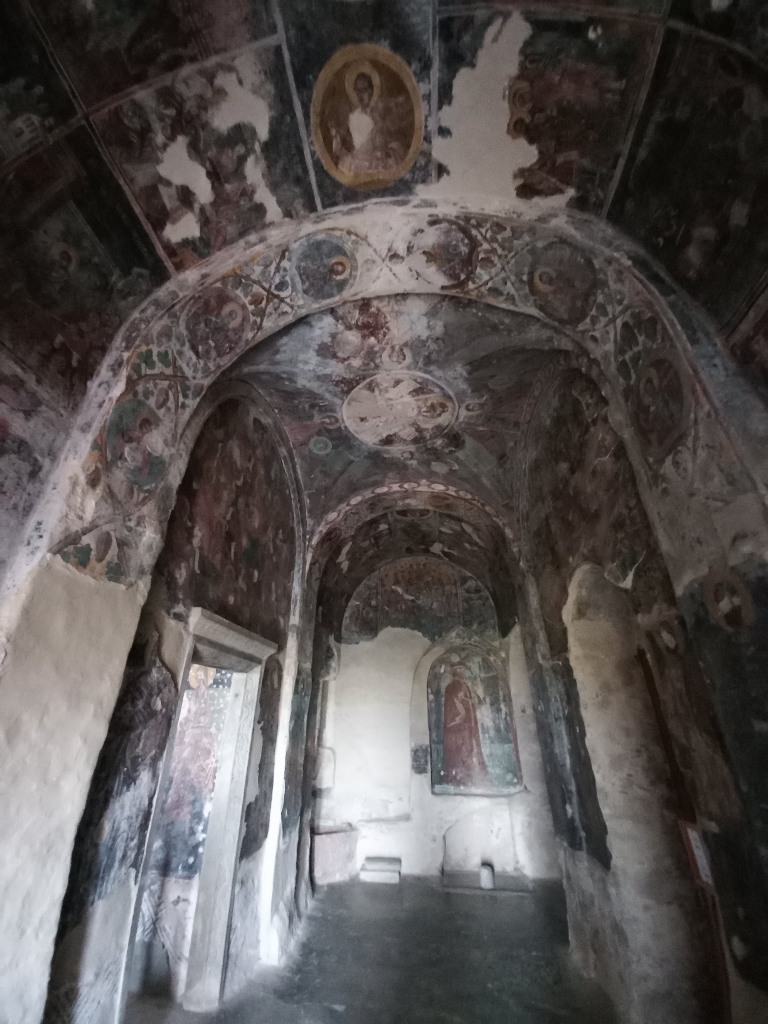 Pantanassa Monastery, a detail
Pantanassa Monastery, a detail
Having spent enough time at the Pantanassa Monastery to appreciate it, I moved on along a narrow path leading to the southern parts of the site. Along the way, I passed by more remains of the medieval town, including residential buildings. As I’ve mentioned, today the churches and monasteries are the most significant parts of the site, but Mystras was a thriving city for centuries, serving as an important centre in this part of the world, as evidenced by the remains of houses and other structures. After all, the majority of the town was occupied by residential buildings. In Byzantium, there were several different types of houses and some of those seen in Mystras clearly convey the quality of life they offered their inhabitants.
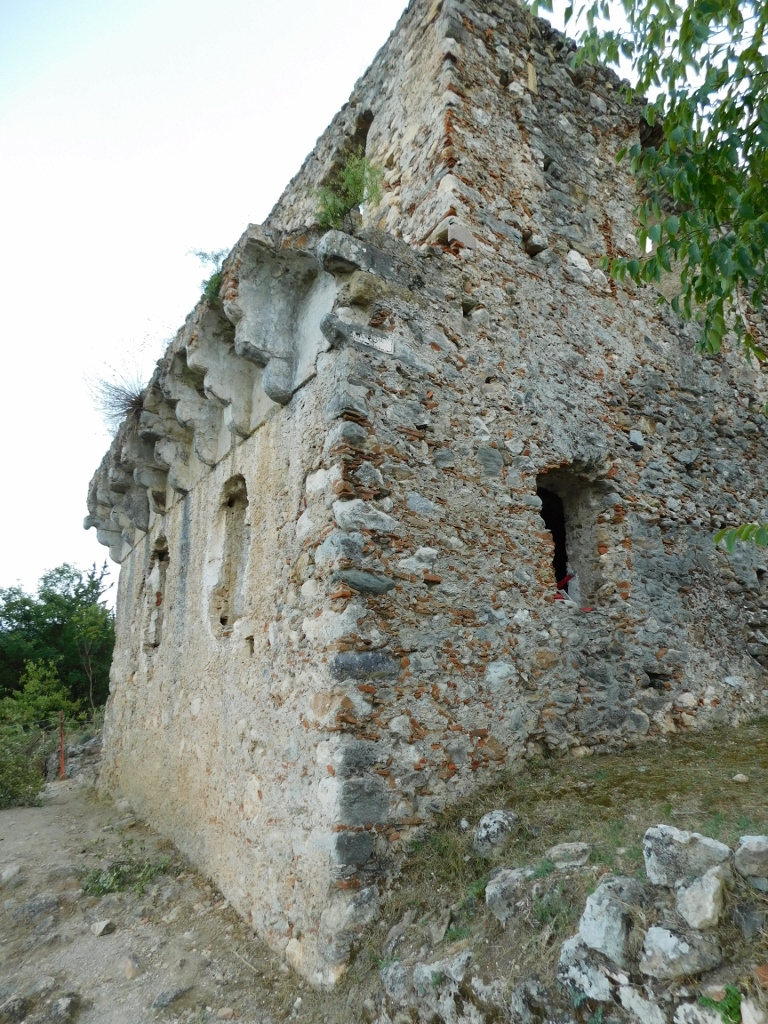 Archaeological Site of Mystras, a detail
Archaeological Site of Mystras, a detail
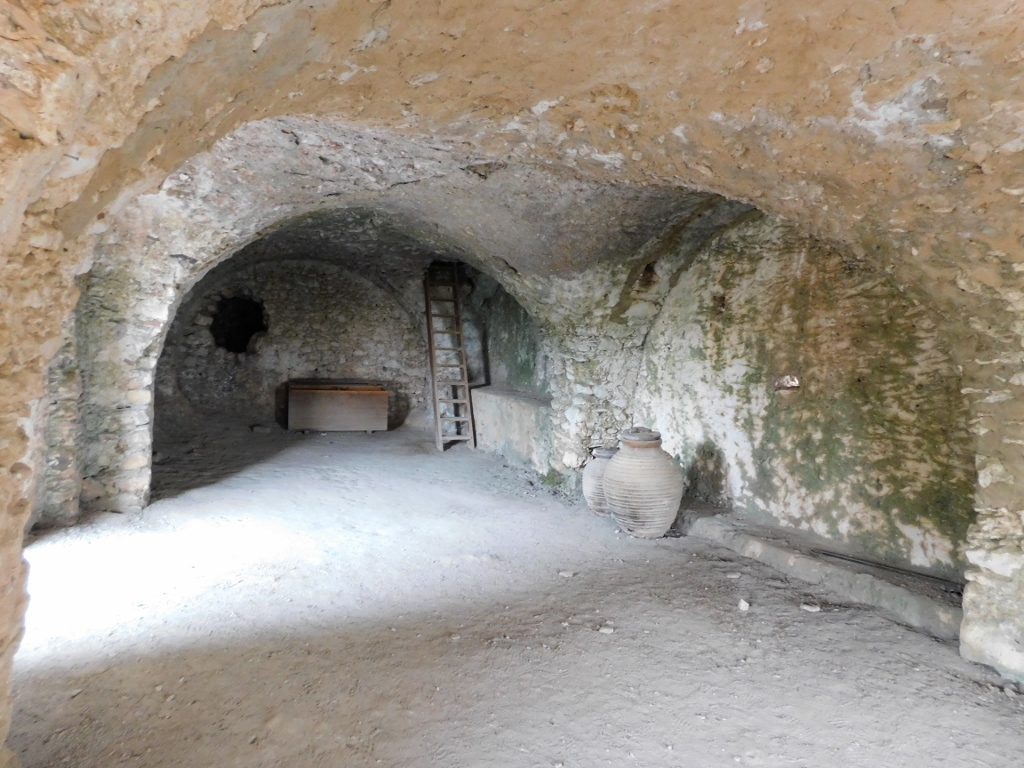 Archaeological Site of Mystras, a detail
Archaeological Site of Mystras, a detail
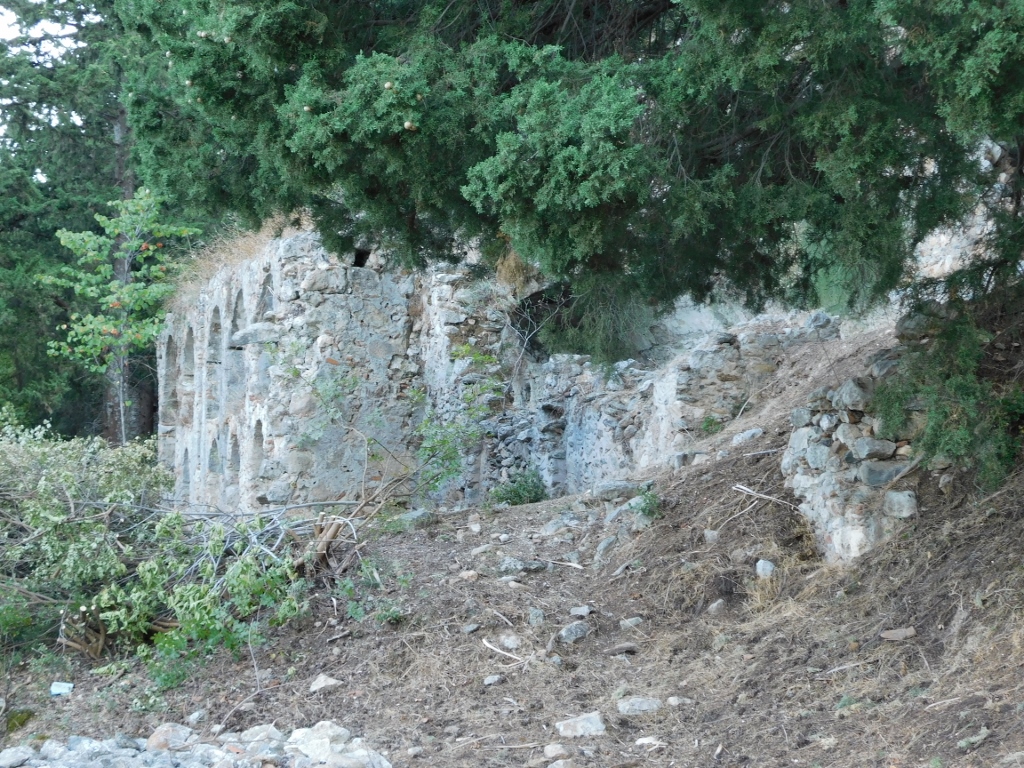 Archaeological Site of Mystras, a detail
Archaeological Site of Mystras, a detail
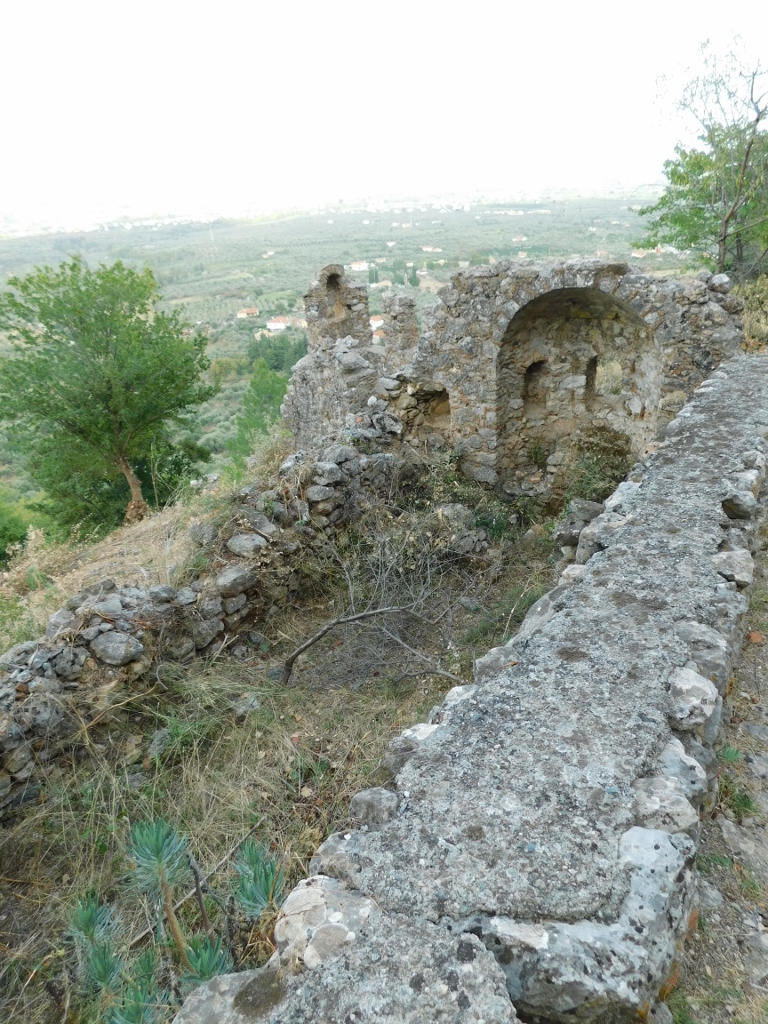 Archaeological Site of Mystras, a detail
Archaeological Site of Mystras, a detail
And so I arrived at the Peribleptos Monastery. The name of the monastery comes from the word "peribleptos," meaning "celebrated" or "blessed," which certainly refers to the Virgin Mary to whom the monastery is dedicated.
First, you come across a gate that is a part of the outer walls surrounding this small medieval monastery.
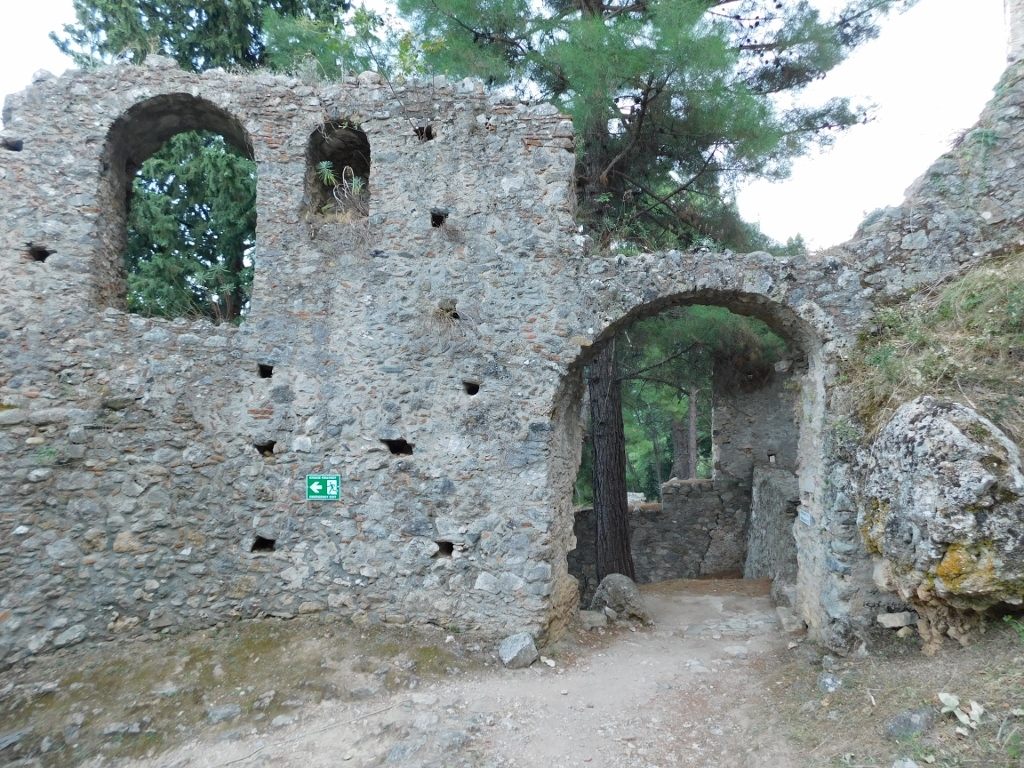 Peribleptos Monastery, a detail
Peribleptos Monastery, a detail
Then you reach the gate through the inner walls.
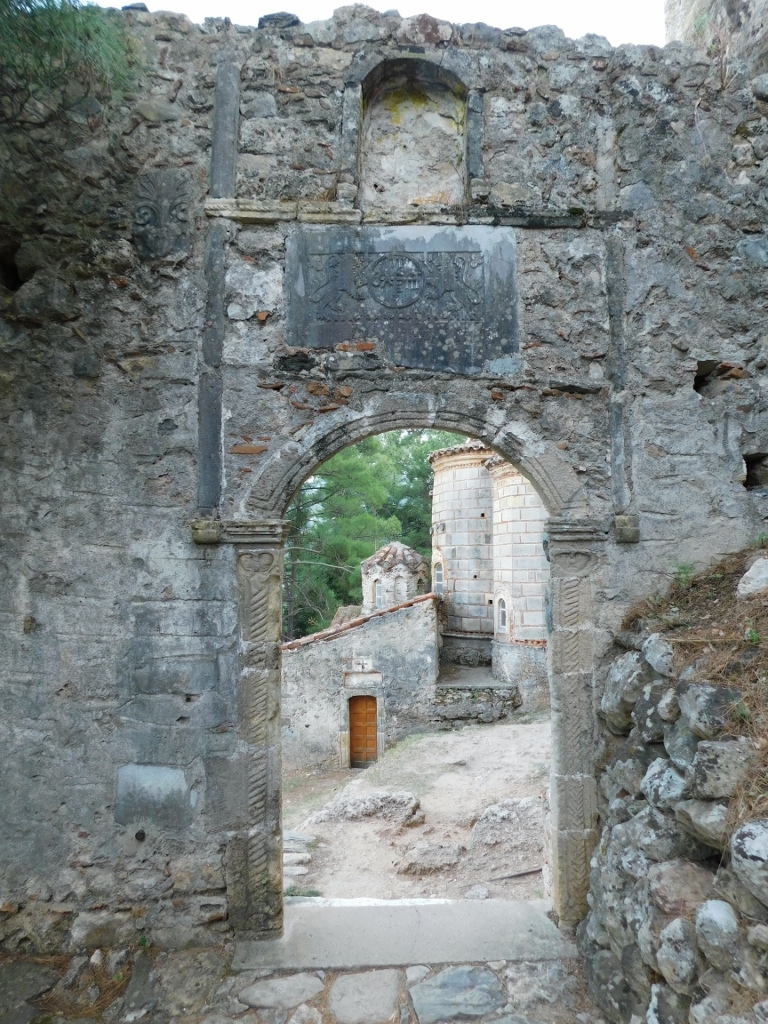 Peribleptos Monastery, a detail
Peribleptos Monastery, a detail
Above the gate leading into the monastery courtyard, there is a stone slab with shallow reliefs. Based on the symbols depicted there, it can be concluded that the monastery was originally founded by the Franks in the 13th century. However, the monastery and church were expanded in the 14th century (1348-1380) during the Byzantine rule, at which time the frescoes were also created.
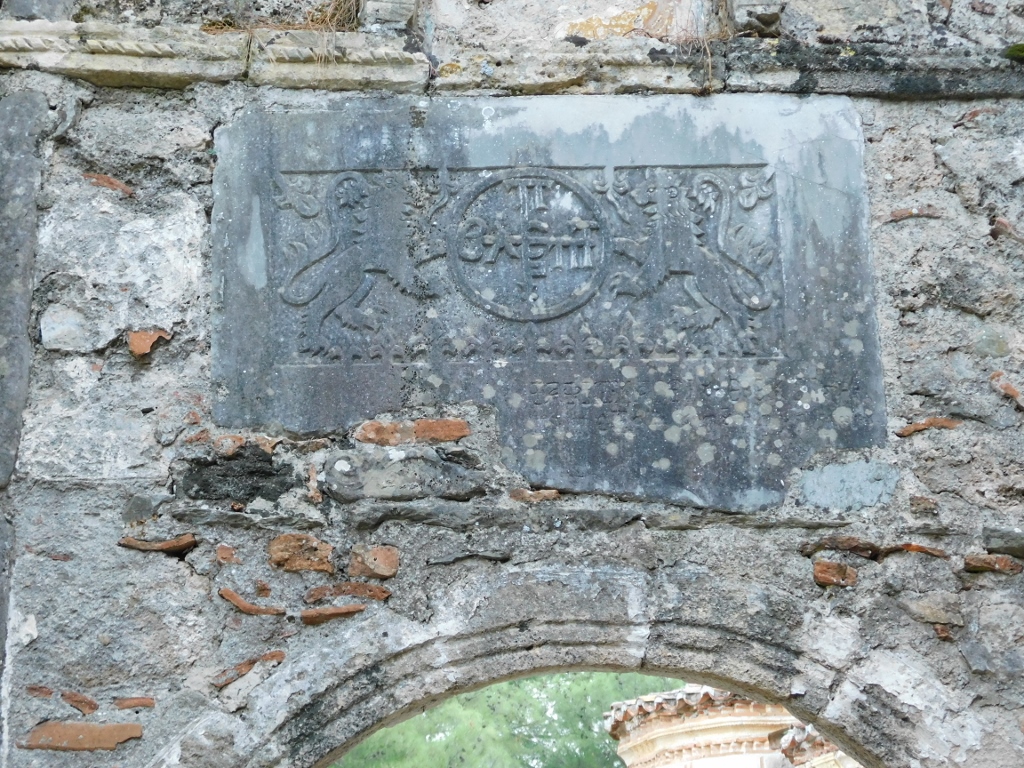 Peribleptos Monastery, a detail
Peribleptos Monastery, a detail
The monastery feels quite secluded compared to the other monasteries and churches in Mystras, and it is indeed rather small. However, to me, this monastery and its church seem to be the most beautiful and picturesque. First, I wandered around the courtyard a bit.
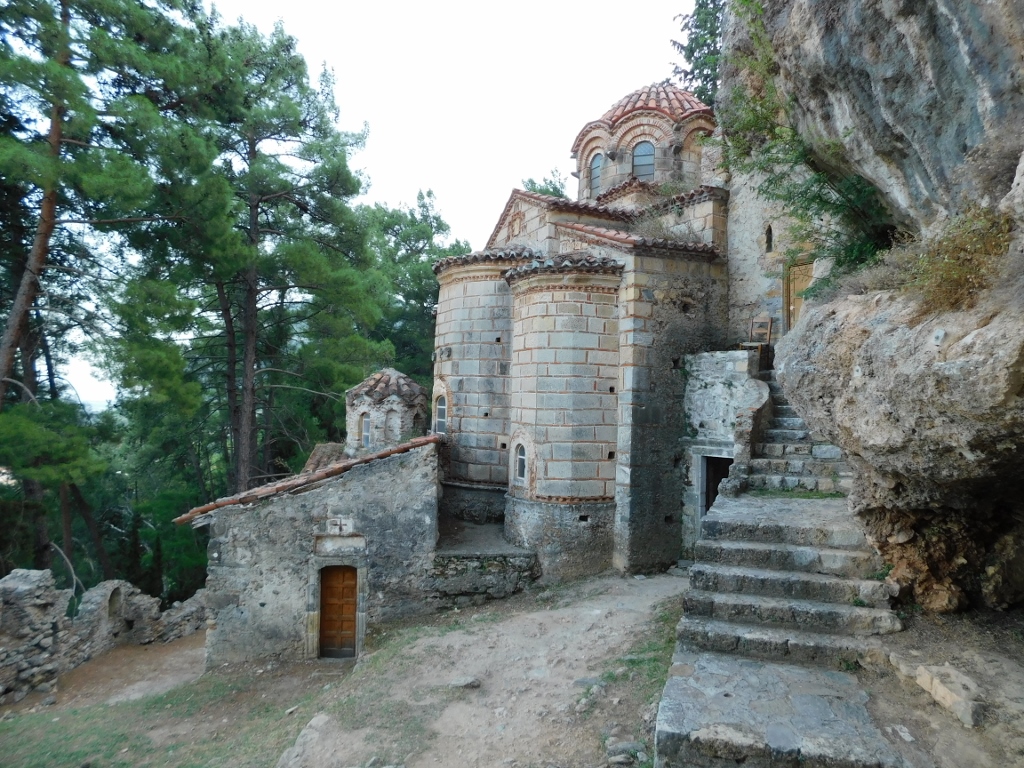 Peribleptos Monastery
Peribleptos Monastery
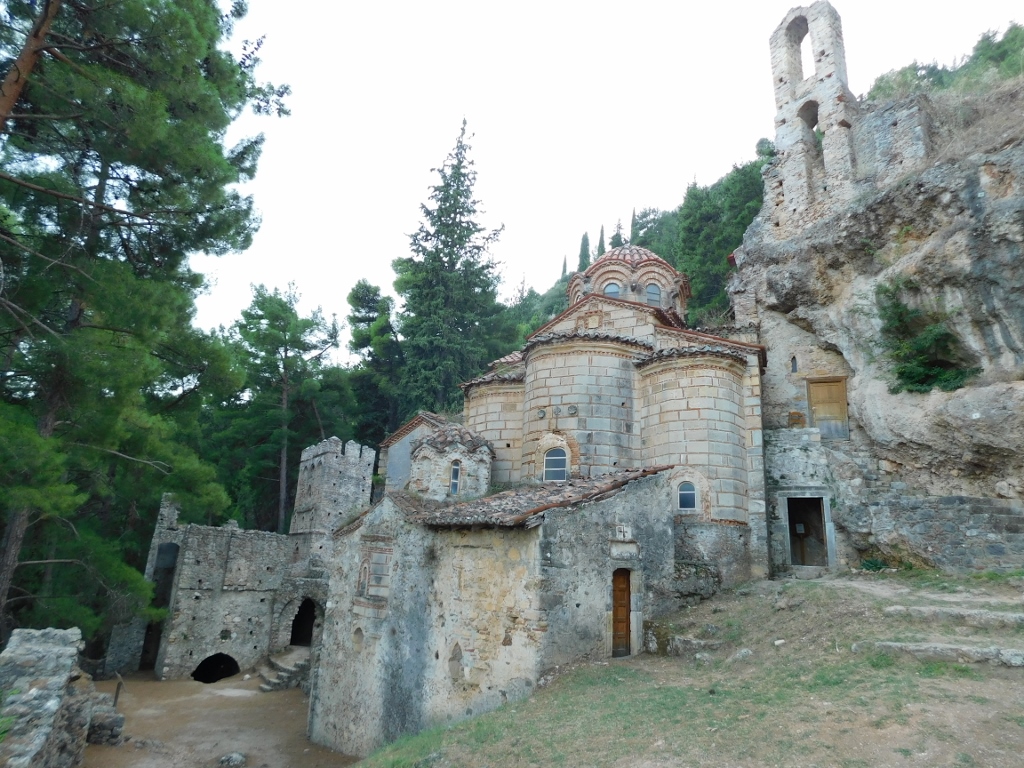 Peribleptos Monastery
Peribleptos Monastery
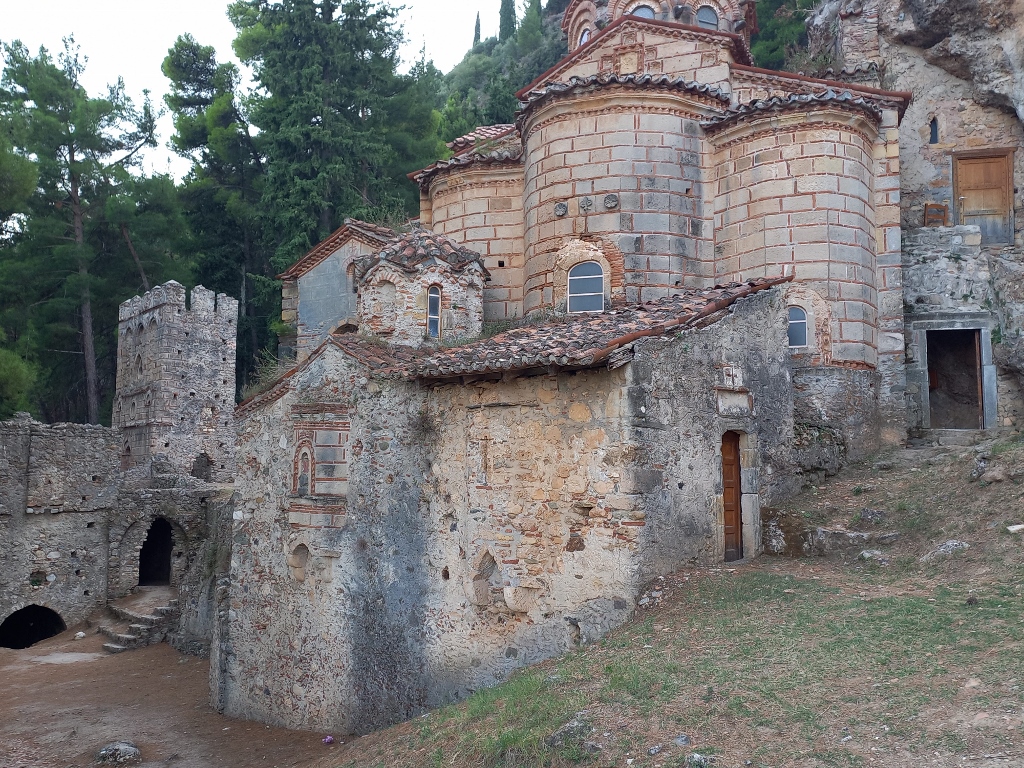 Peribleptos Monastery, a detail
Peribleptos Monastery, a detail
I did the same in 2013, when the light was different, allowing me to capture some details that stood out beautifully.
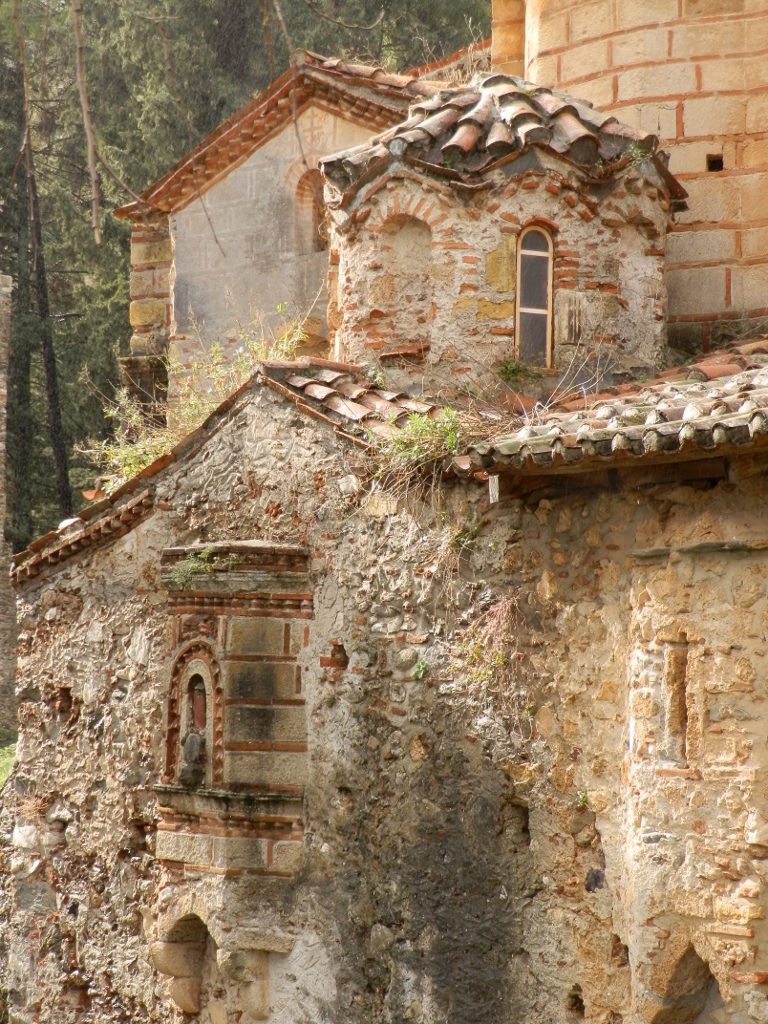 Peribleptos Monastery, a detail (2013)
Peribleptos Monastery, a detail (2013)
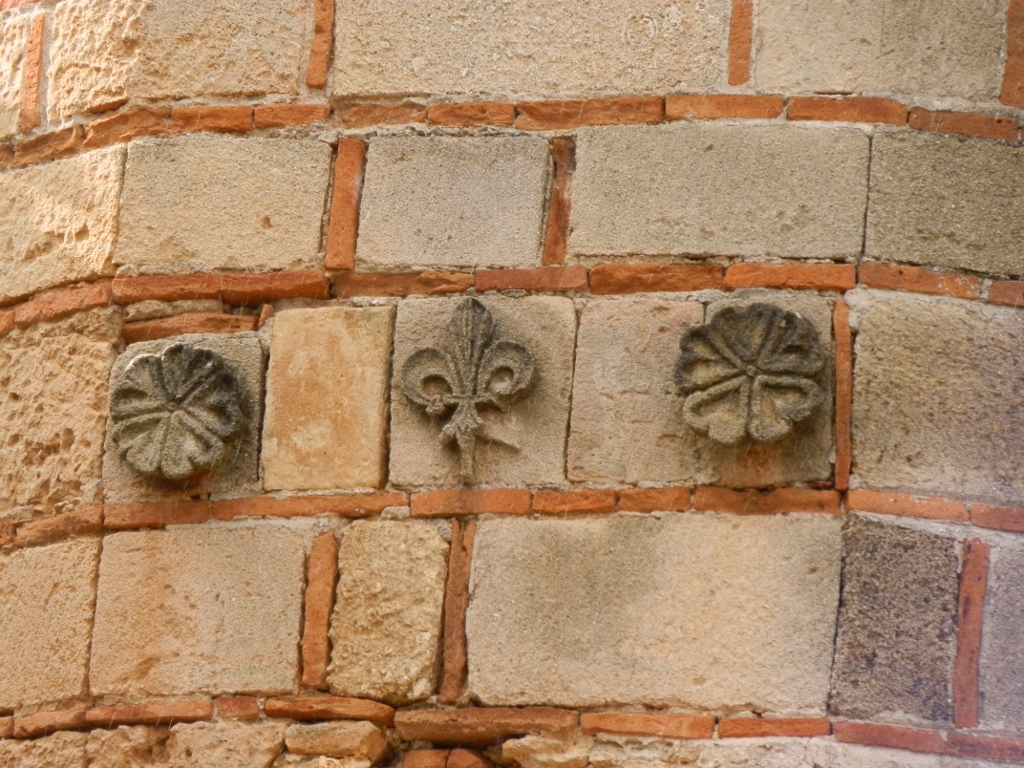 Peribleptos Monastery, a detail (2013)
Peribleptos Monastery, a detail (2013)
The monastery is located almost at the southern edge of the entire site, where you can see the walls and a tower. It’s possible that this was part of the city’s fortifications or it may have been specific to the monastery itself. I wasn’t able to find any information regarding that.
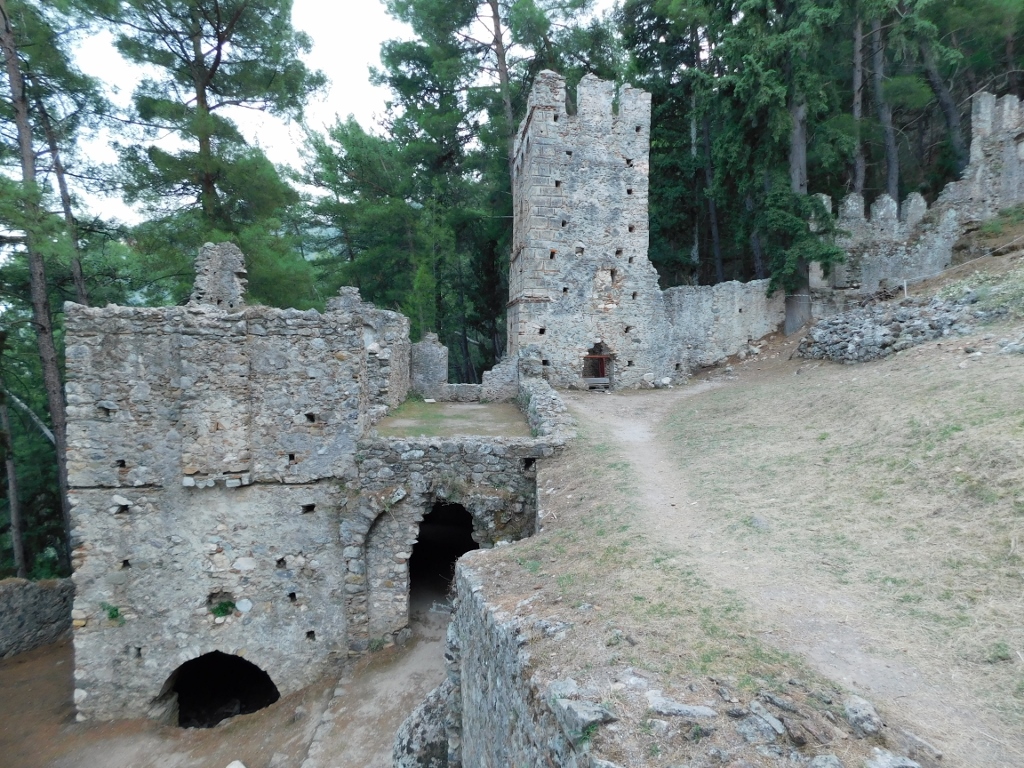 Peribleptos Monastery, a detail
Peribleptos Monastery, a detail
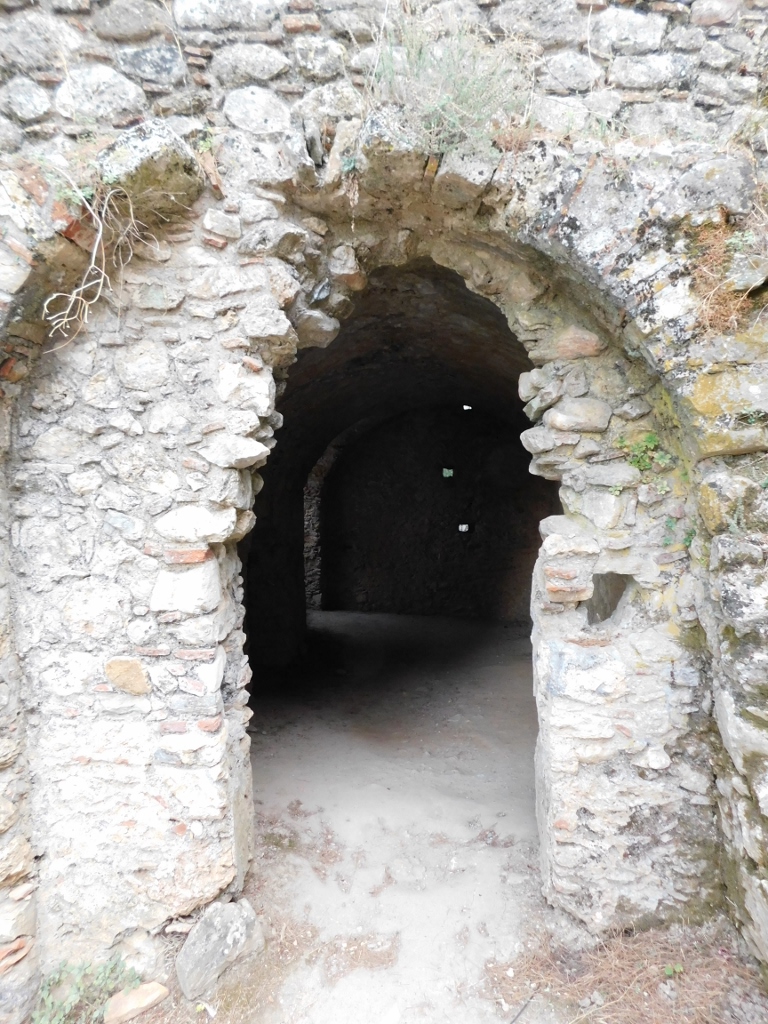 Peribleptos Monastery, a detail
Peribleptos Monastery, a detail
In any case, I now started to climb the steps leading up to the monastery church.
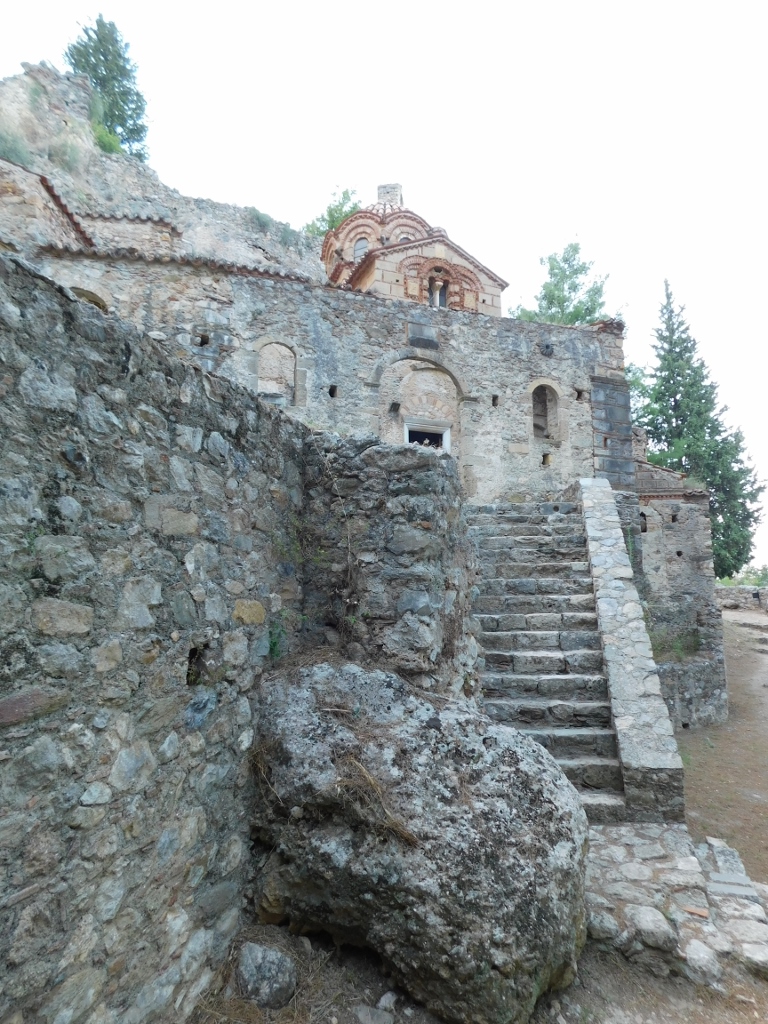 Peribleptos Monastery, a detail
Peribleptos Monastery, a detail
Still, this reminded me of a similar perspective I captured in 2013, when rainbows appeared several times and at very different locations.
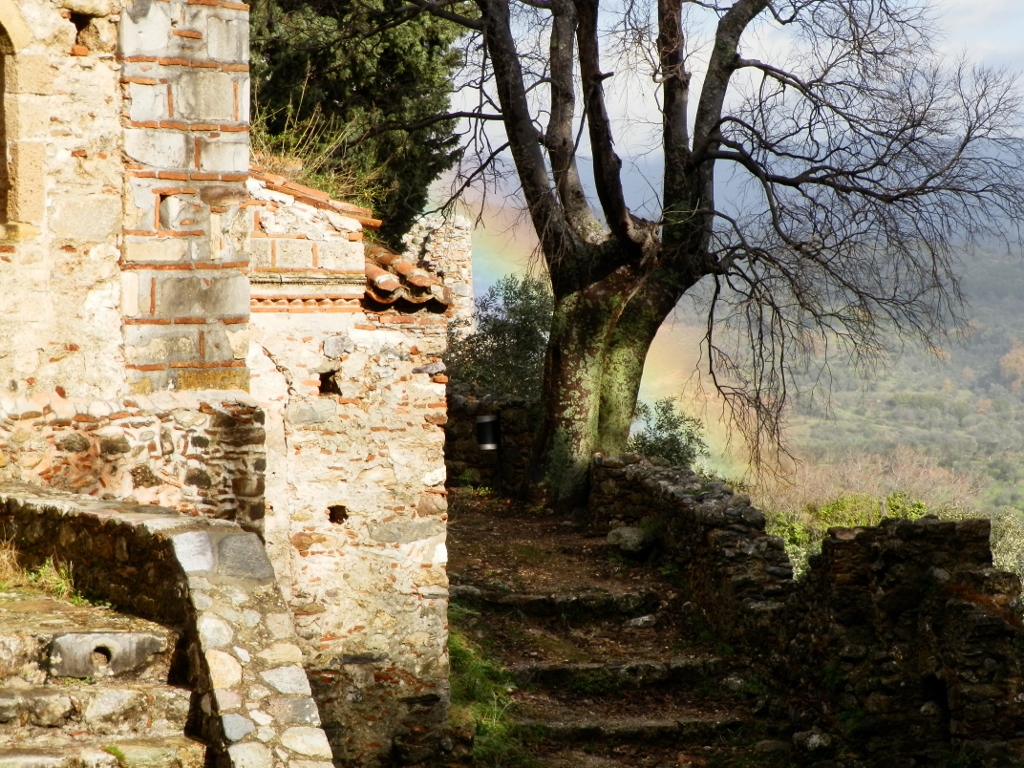 Peribleptos Monastery, a detail (2013)
Peribleptos Monastery, a detail (2013)
As for the church, it is built right against the cliff, which further supports the entire structure. You can enter the church through several doors and at one spot, I even saw the Eye of Providence on the floor.
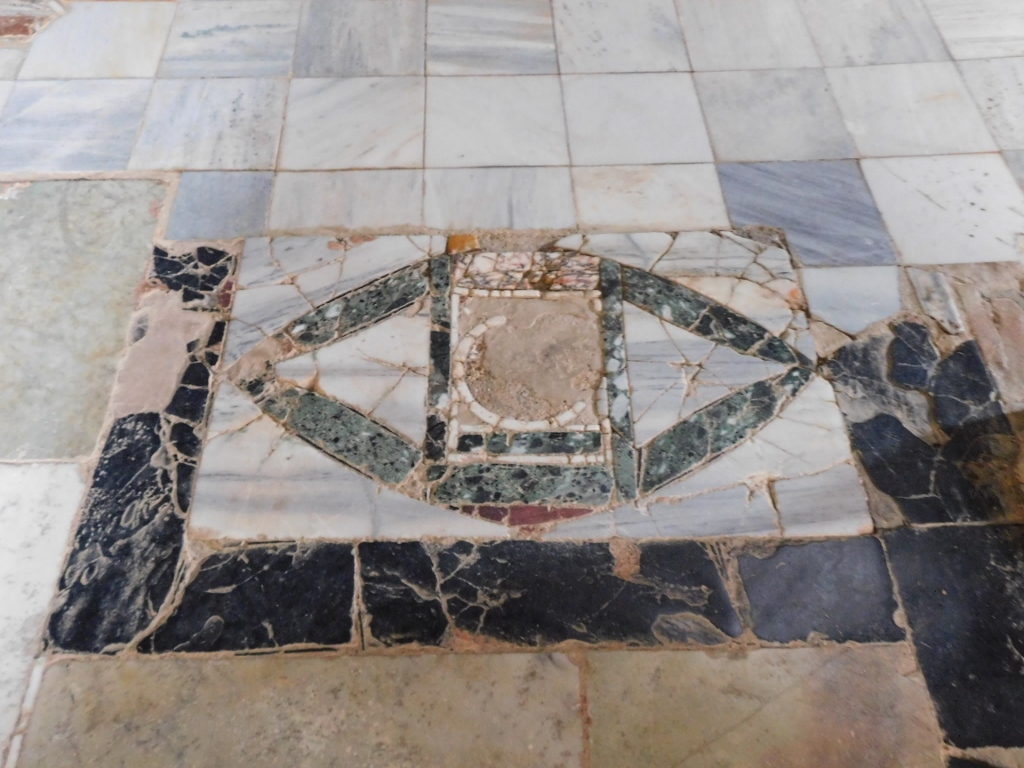 Peribleptos Monastery, a detail
Peribleptos Monastery, a detail
But what is particularly beautiful are the well-preserved frescoes painted between 1350 and 1375. It is believed that the artists of this remarkably preserved artwork were members of the Cretan and Macedonian artistic schools.
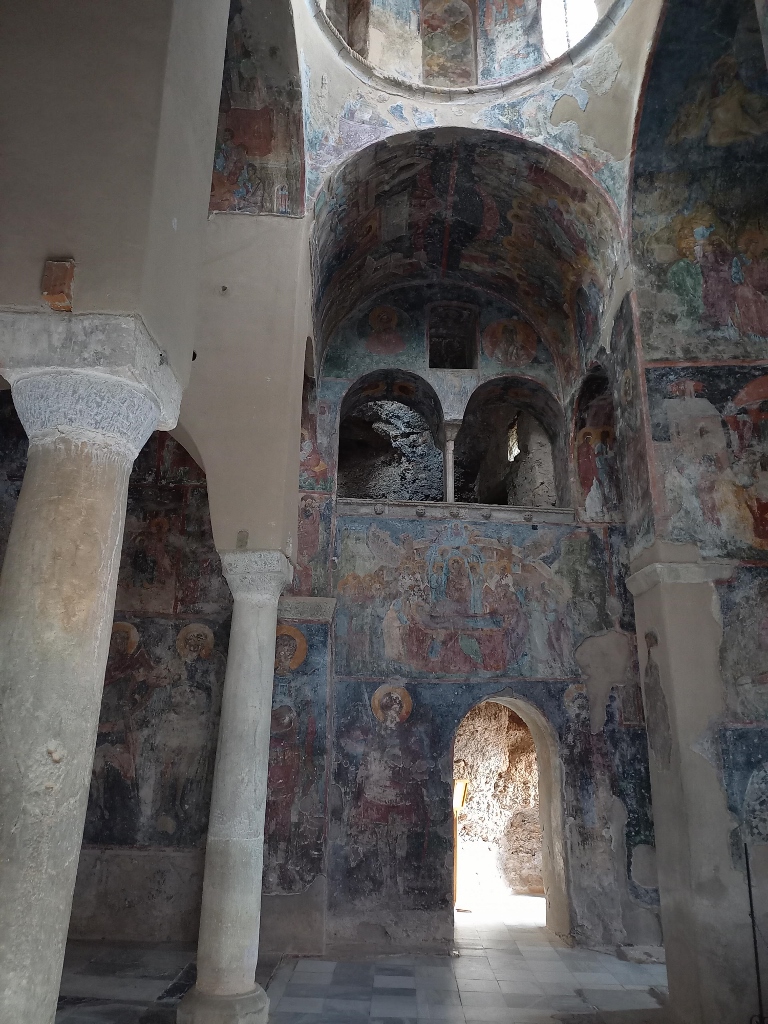 Peribleptos Monastery, a detail
Peribleptos Monastery, a detail
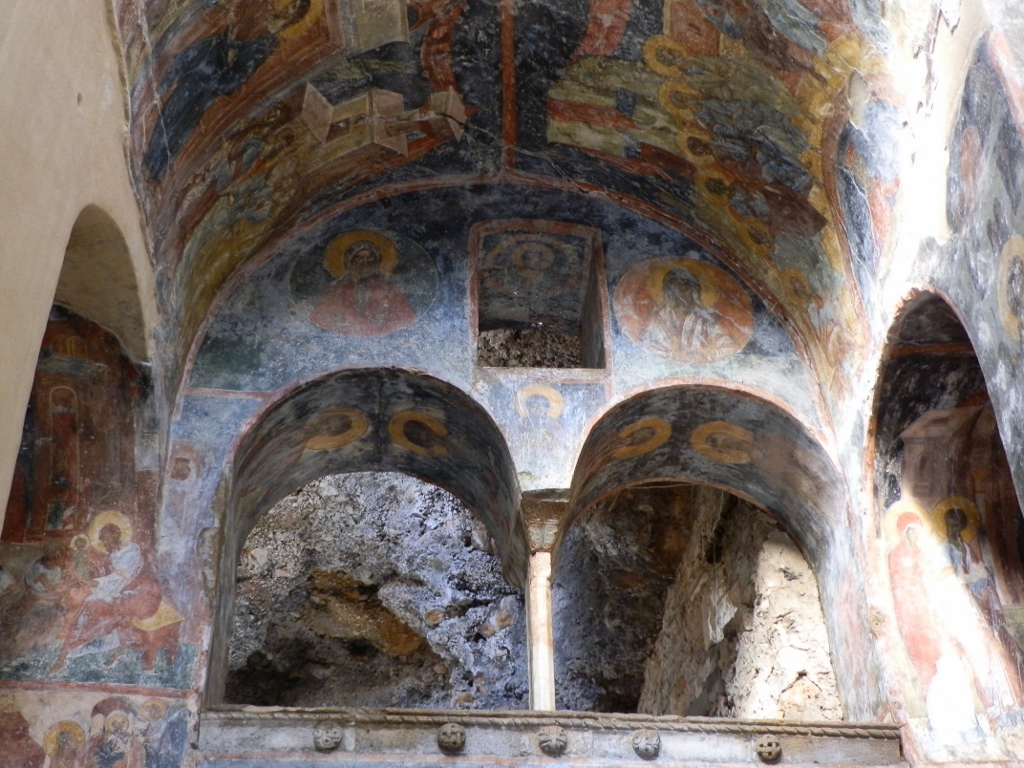 Peribleptos Monastery, a detail
Peribleptos Monastery, a detail
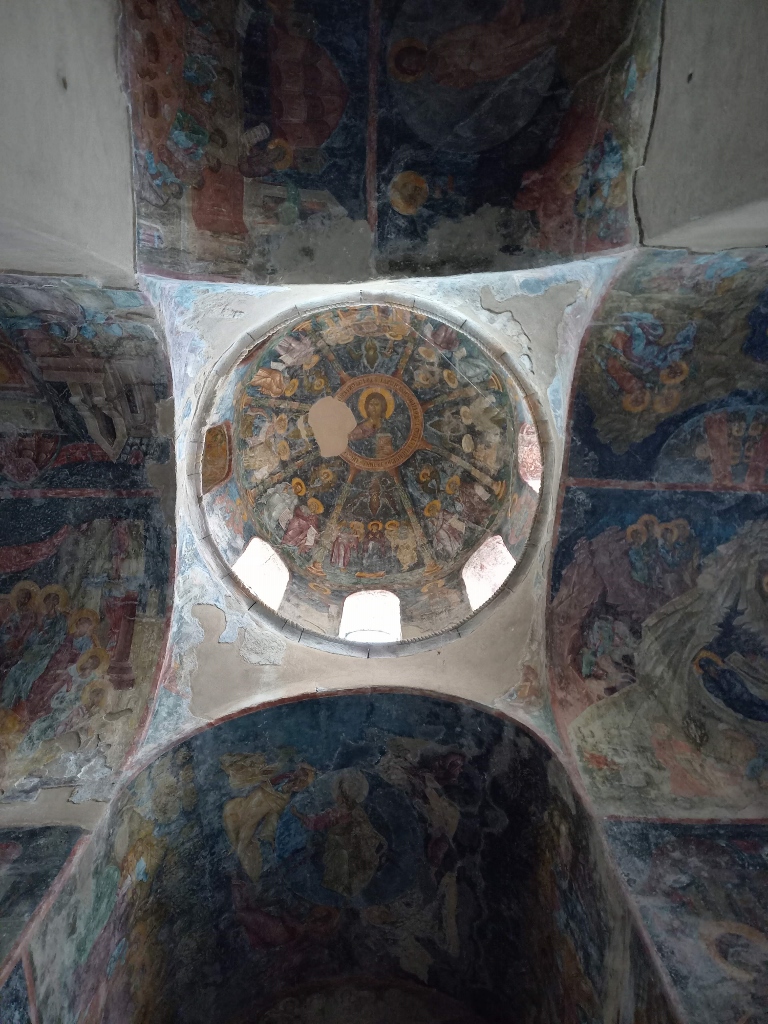 Peribleptos Monastery, a detail
Peribleptos Monastery, a detail
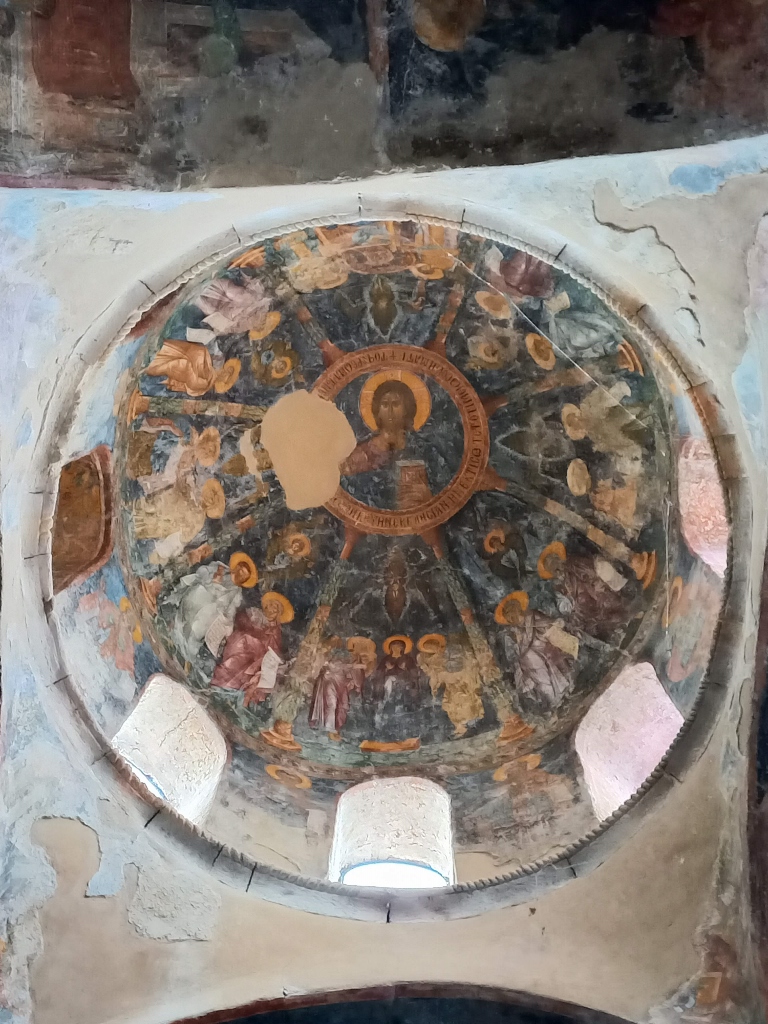 Peribleptos Monastery, a detail
Peribleptos Monastery, a detail
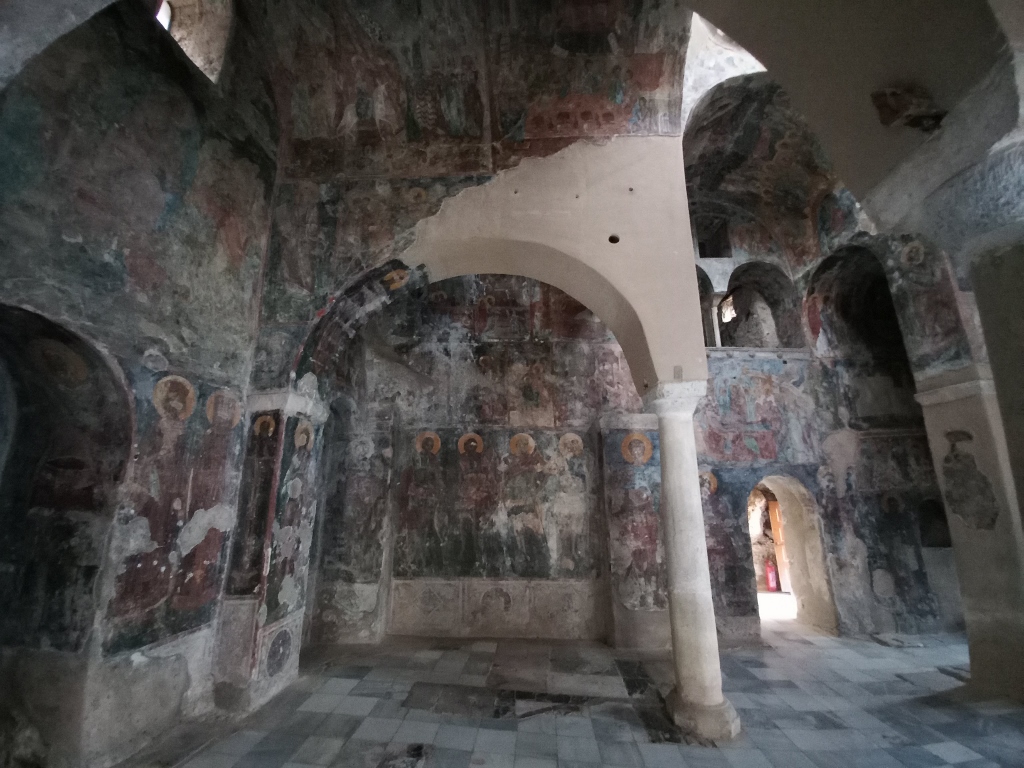 Peribleptos Monastery, a detail
Peribleptos Monastery, a detail
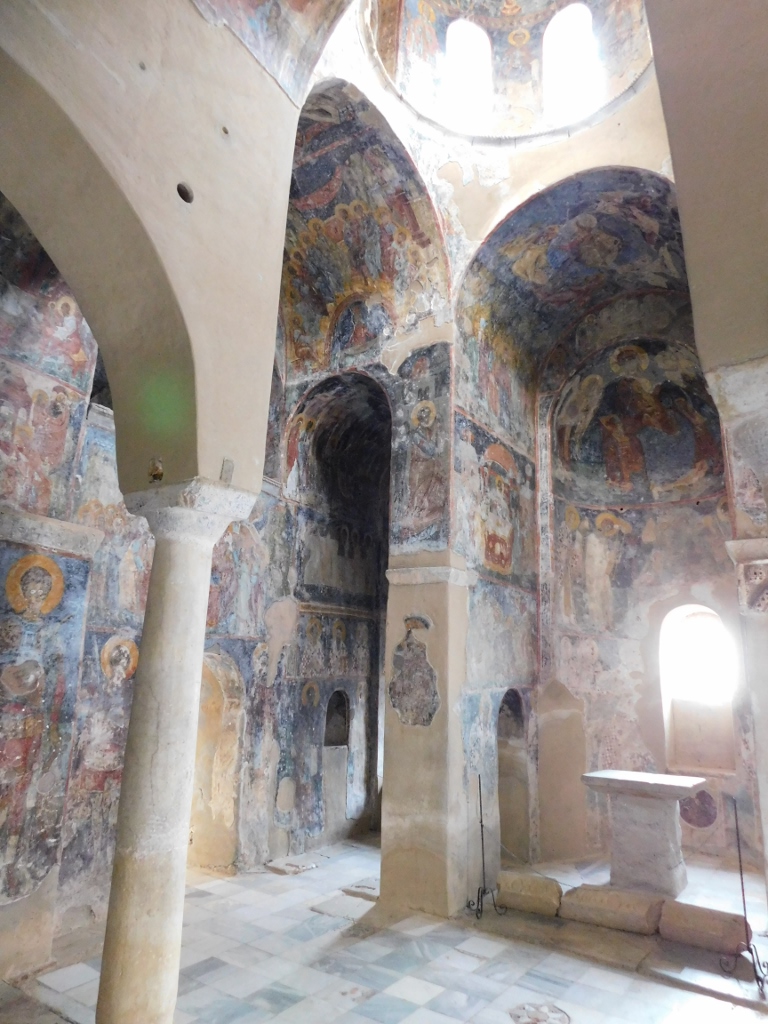 Peribleptos Monastery, a detail
Peribleptos Monastery, a detail
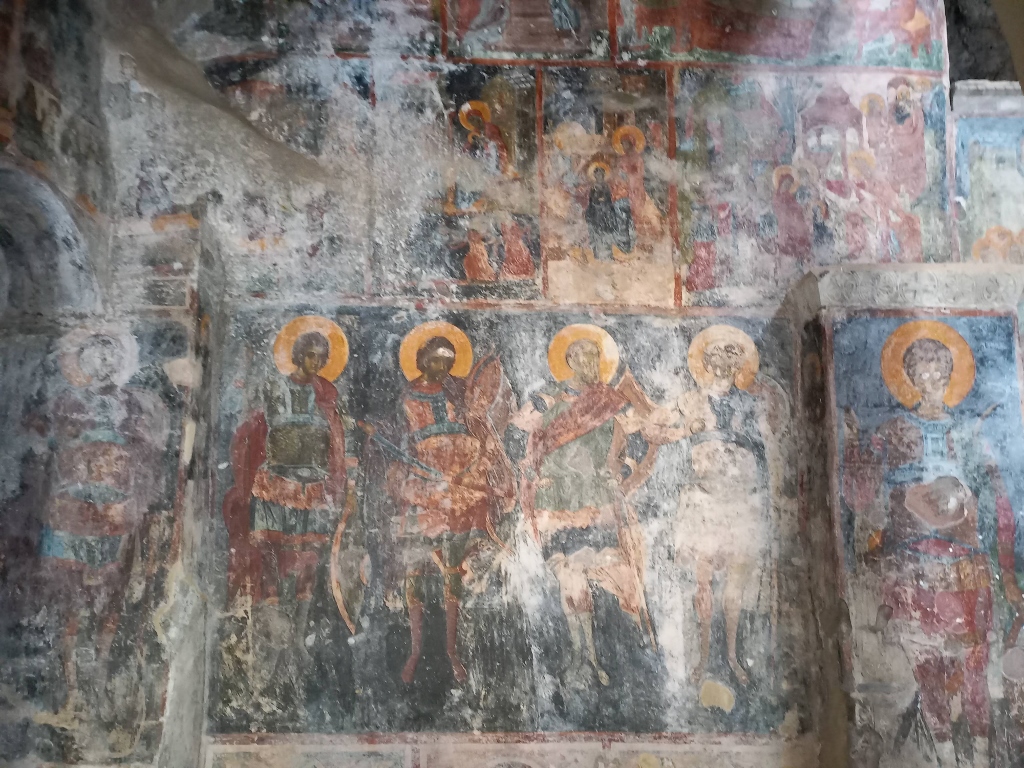 Peribleptos Monastery, a detail
Peribleptos Monastery, a detail
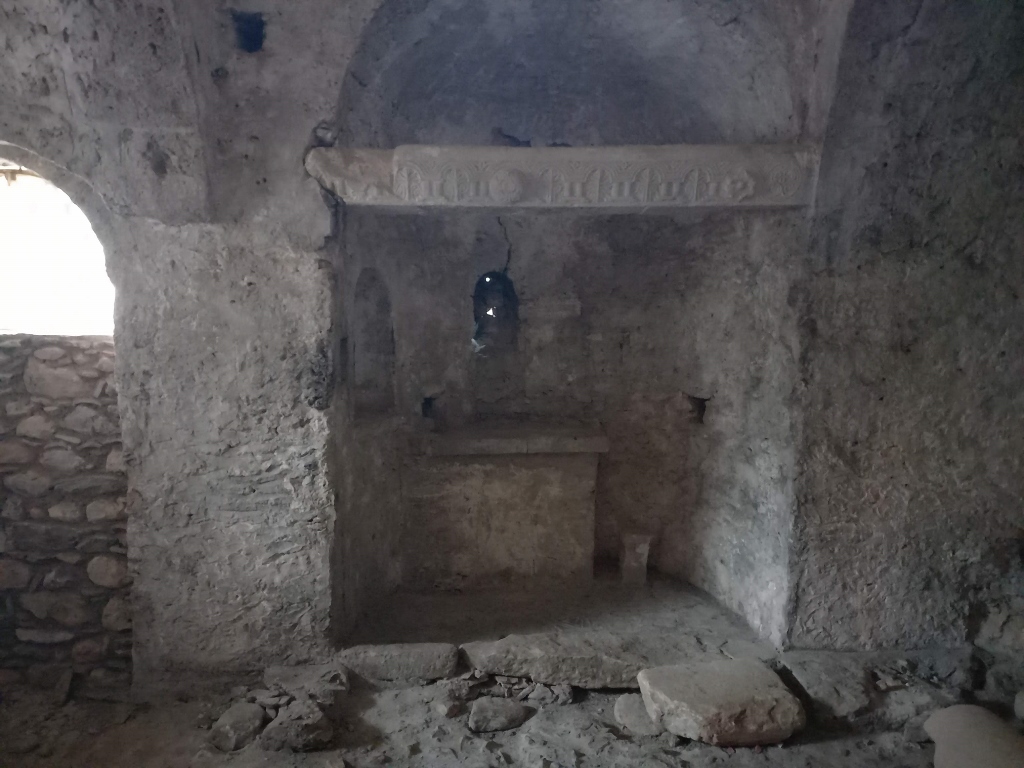 Peribleptos Monastery, a detail
Peribleptos Monastery, a detail
I thoroughly enjoyed exploring this monastery and its church, but it was time to start making my way back to the exit. I knew I would pass by a few more interesting sites along the way.
The first was the exceptionally well-executed sepulchral Chapel of St. George. I photographed it during both visits to the site, but the picture from 2013 turned out better due to the position of the sun.
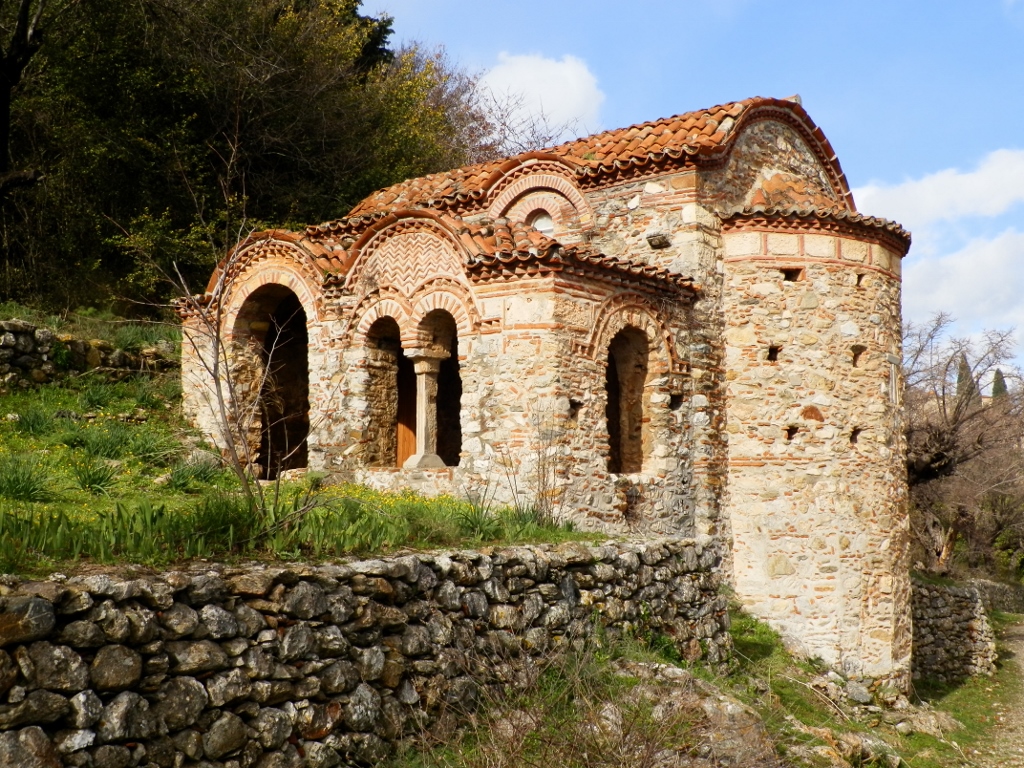 Chapel of St. George
Chapel of St. George
In this section, the path is mostly flat, meaning there isn’t much up and down, which also made it easier for me to explore.
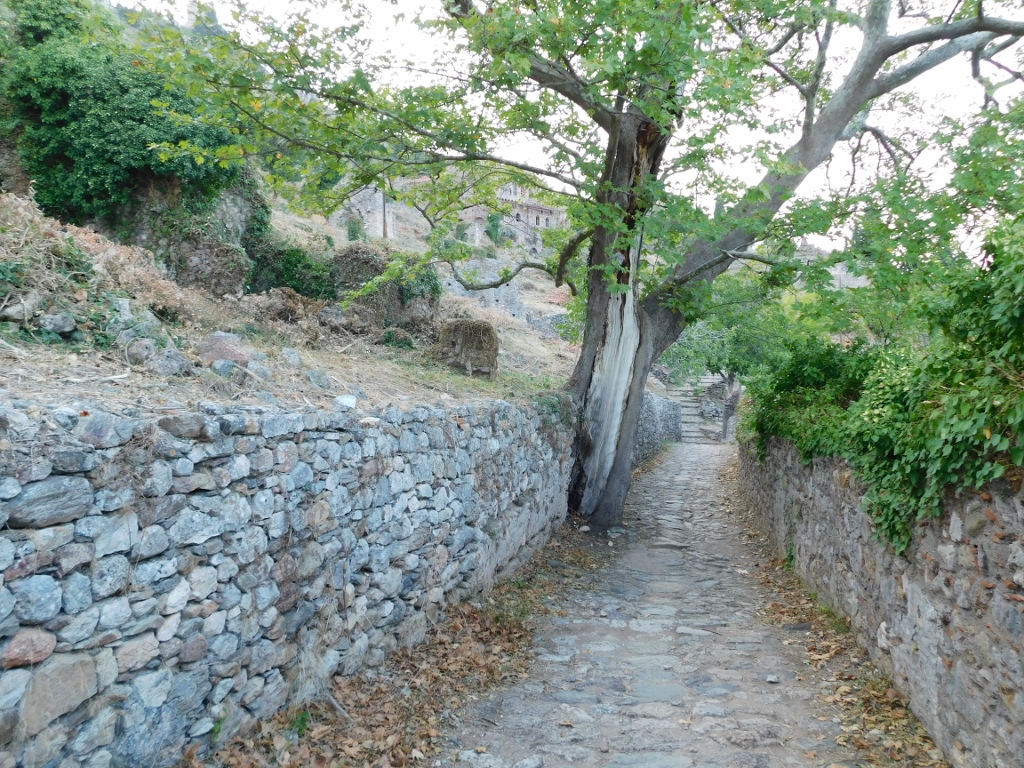 Archaeological Site of Mystras, a detail
Archaeological Site of Mystras, a detail
At one point along the path, you can also see the Pantanassa Monastery, as well as various other structures.
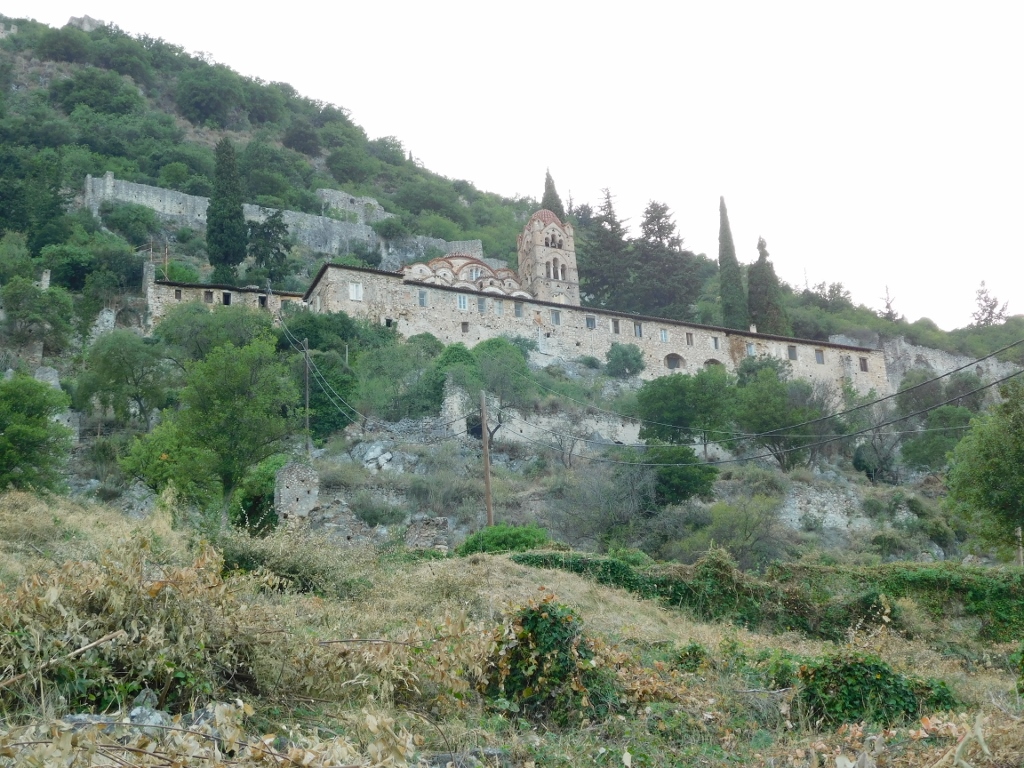 Pantanassa Monastery
Pantanassa Monastery
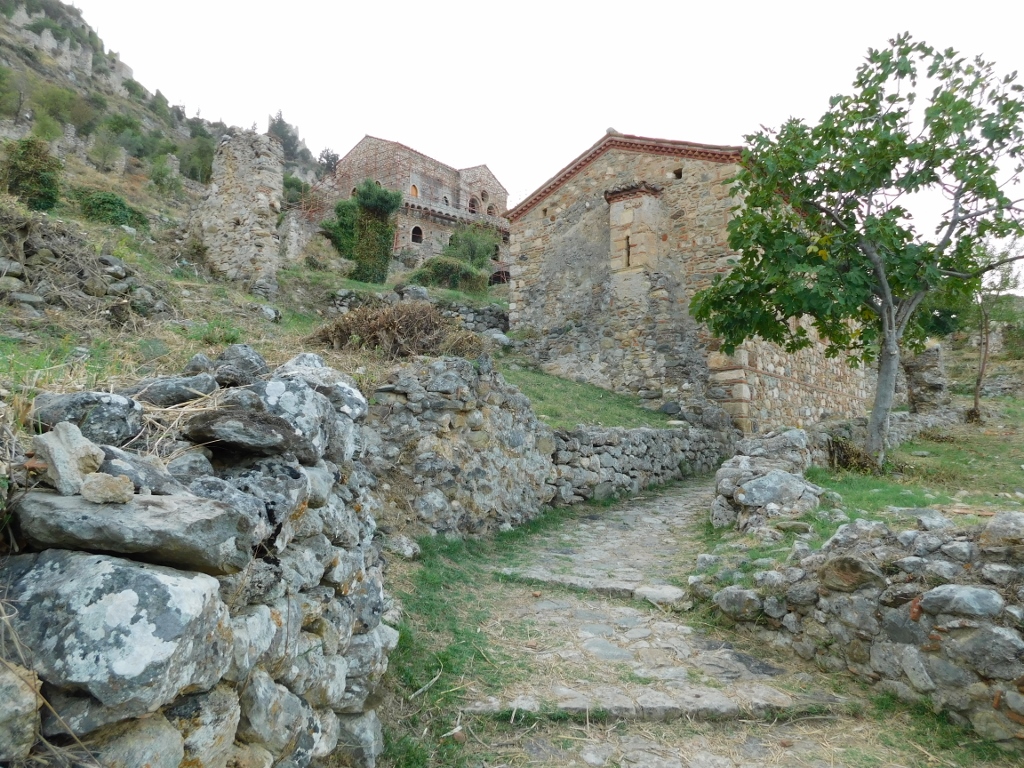 Archaeological Site of Mystras, a detail
Archaeological Site of Mystras, a detail
And then I arrived at the Church of St. Christopher from the 14th century, which is situated right next to the path, or rather, the former city street.
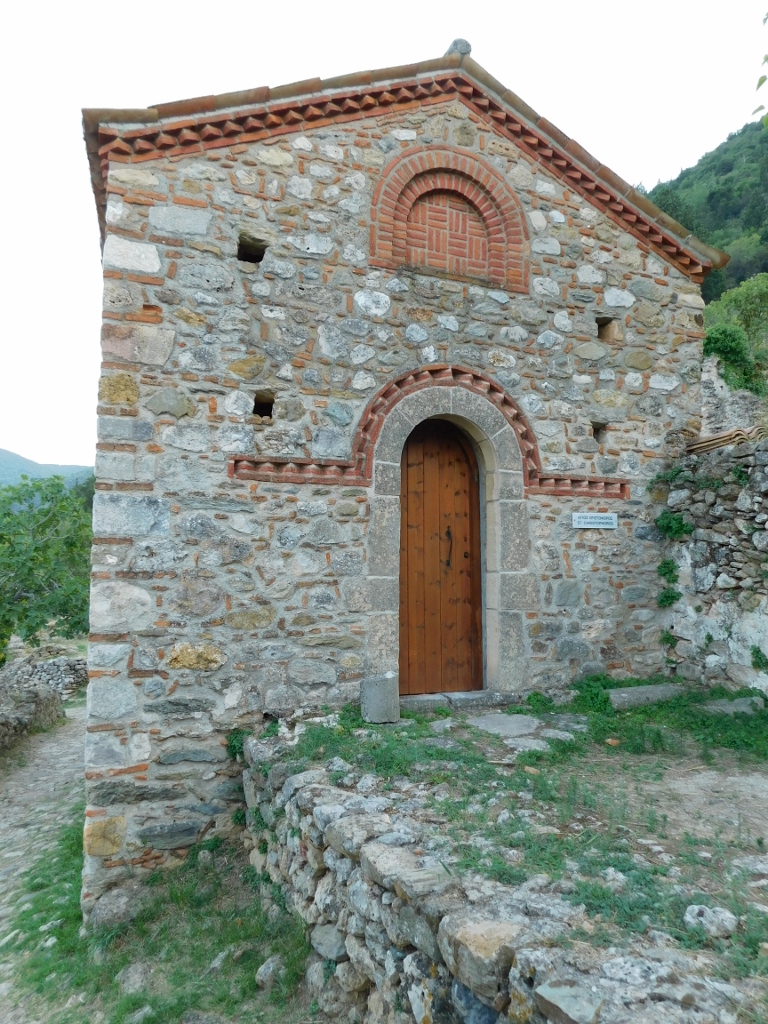 Church of St. Christofer
Church of St. Christofer
When I passed by here in September 2023, the church was closed, but that wasn’t the case in 2013. At that time, I went inside and took a couple of photos.
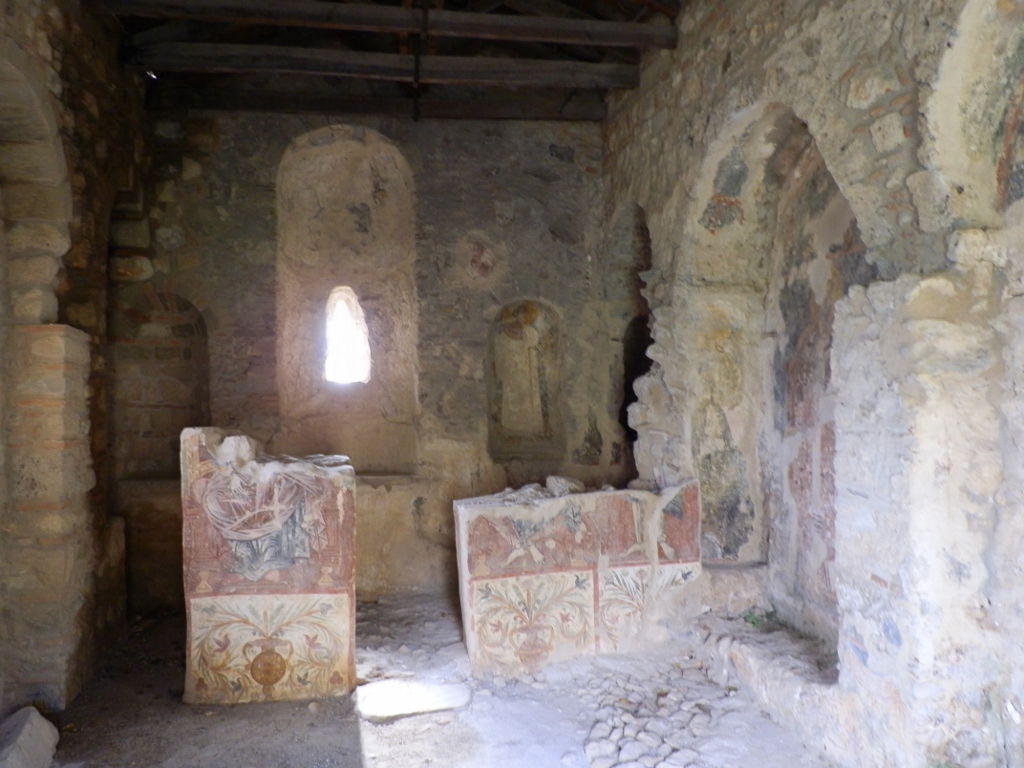 Church of St. Christofer, a detail
Church of St. Christofer, a detail
From the courtyard in front of the church, there is also a wonderful view of the site – I was still amazed not only by the beauty of the structures and the place itself, but also by the thought that people once lived and functioned here. They didn’t need to go jogging or to the gym.
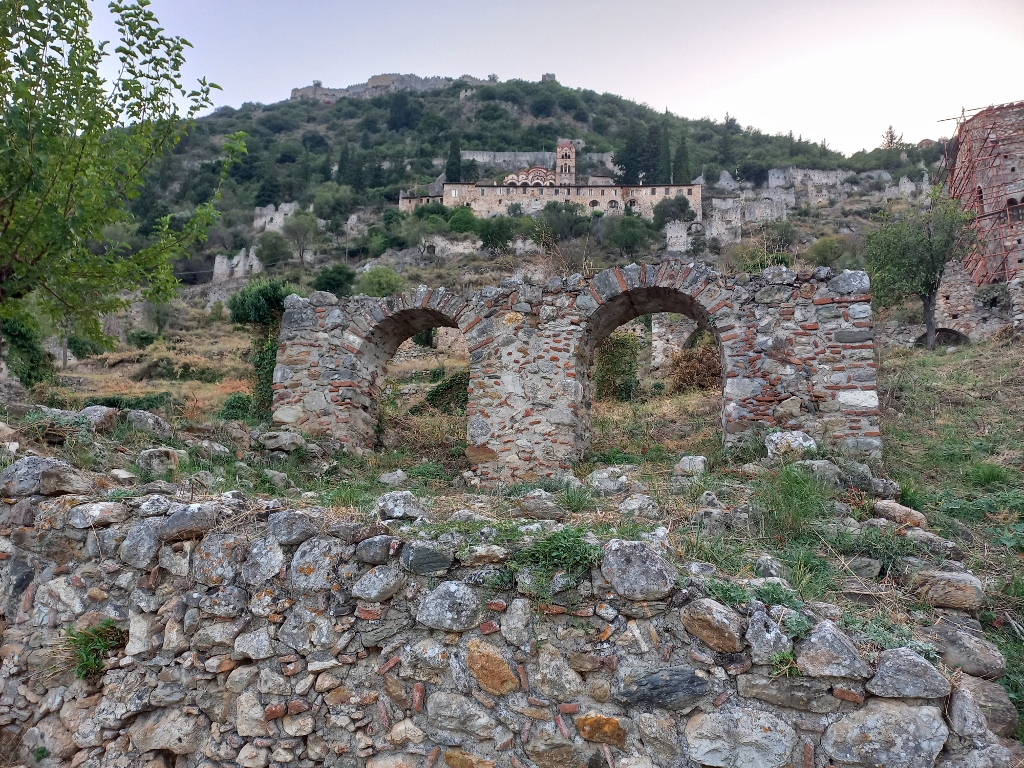 Archaeological Site of Mystras, a detail
Archaeological Site of Mystras, a detail
On the right-hand side of the previous photo, you can also see a part of the Lascaris House that was undergoing restoration in autumn 2023.
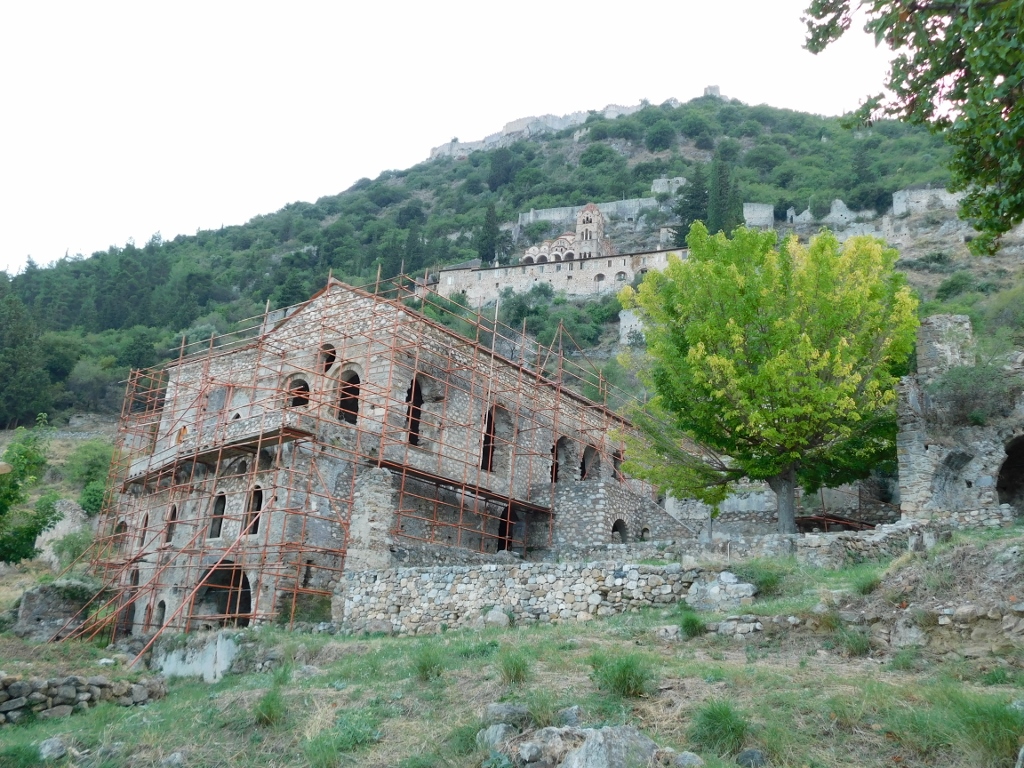 Lascaris House
Lascaris House
It constitutes a beautiful example of a noble house from the 14th century and is believed to have belonged to this famous family that was connected with the Byzantine emperors. The house has two levels, with the upper one serving as the main living area.
In this part of the site, there are also numerous other houses, as well as structures that served different purposes, such as the fountain in the next photo. It’s worth mentioning that the houses and other buildings in Mystras were also heavily utilised during the Ottoman period, though changes were made to both their internal organisation and external appearance at that time.
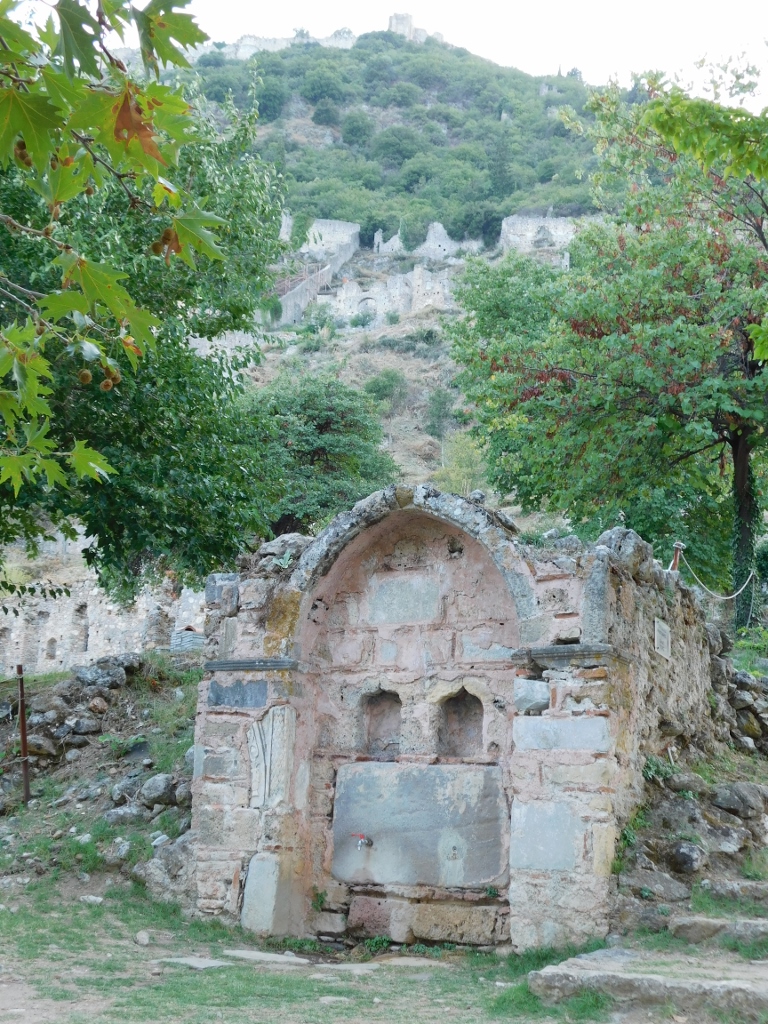 Archaeological Site of Mystras, a detail
Archaeological Site of Mystras, a detail
Nearby is a structure known as the Chronis Residence.
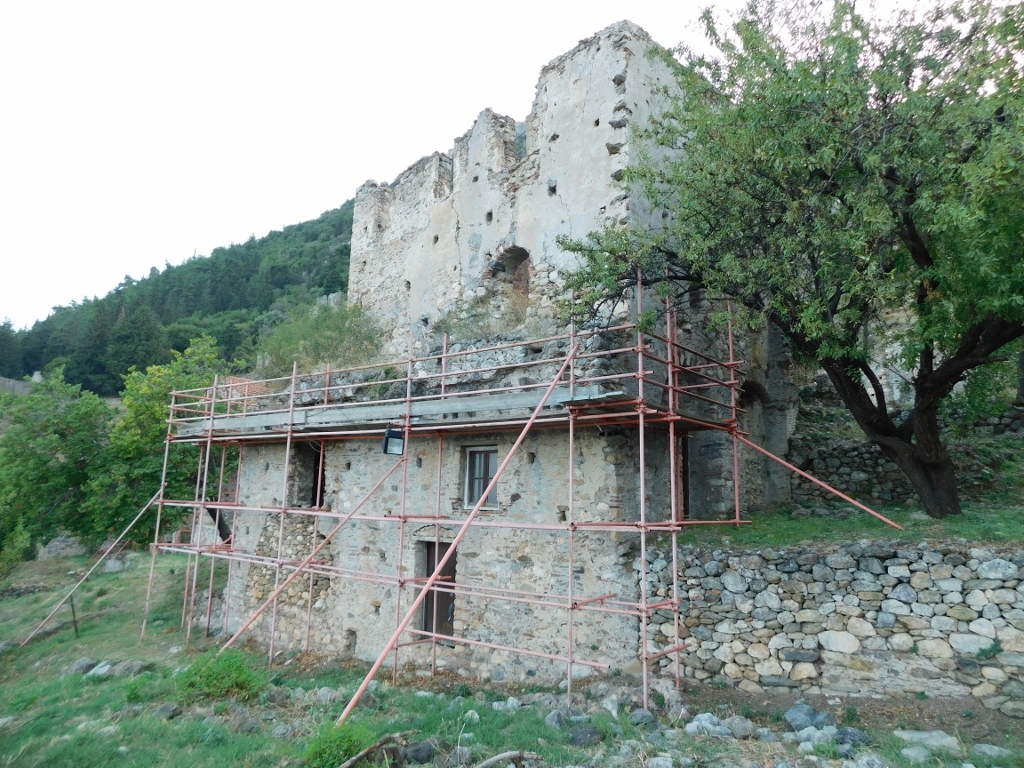 Chronis Residence
Chronis Residence
In this part of the site, the houses are in quite good condition, generally consisting of a ground floor and one upper floor, rarely two. Typically, the ground floor was used for storage, stables and as cooking areas, while the living quarters were on the upper floor.
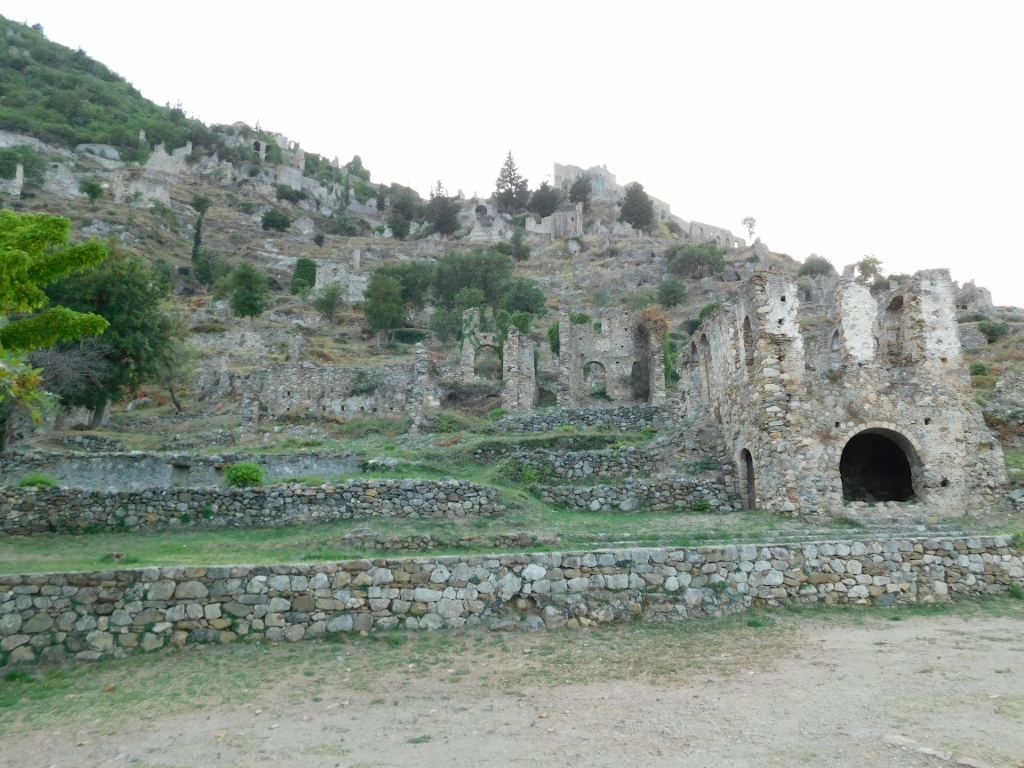 Archaeological Site of Mystras, a detail
Archaeological Site of Mystras, a detail
Here, I reached an expansion, a plateau, from where I had a lovely view of the surroundings. However, I found it much more interesting to take a moment at the end of my visit to Mystras to admire this impressive medieval site once more.
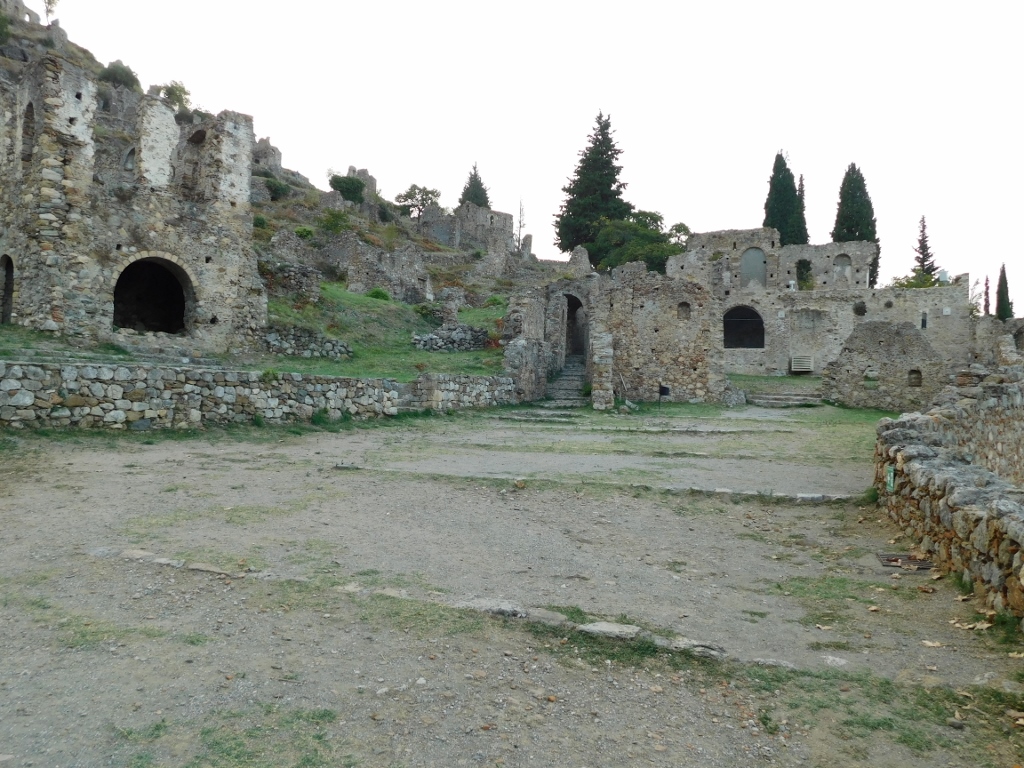 Archaeological Site of Mystras, a detail
Archaeological Site of Mystras, a detail
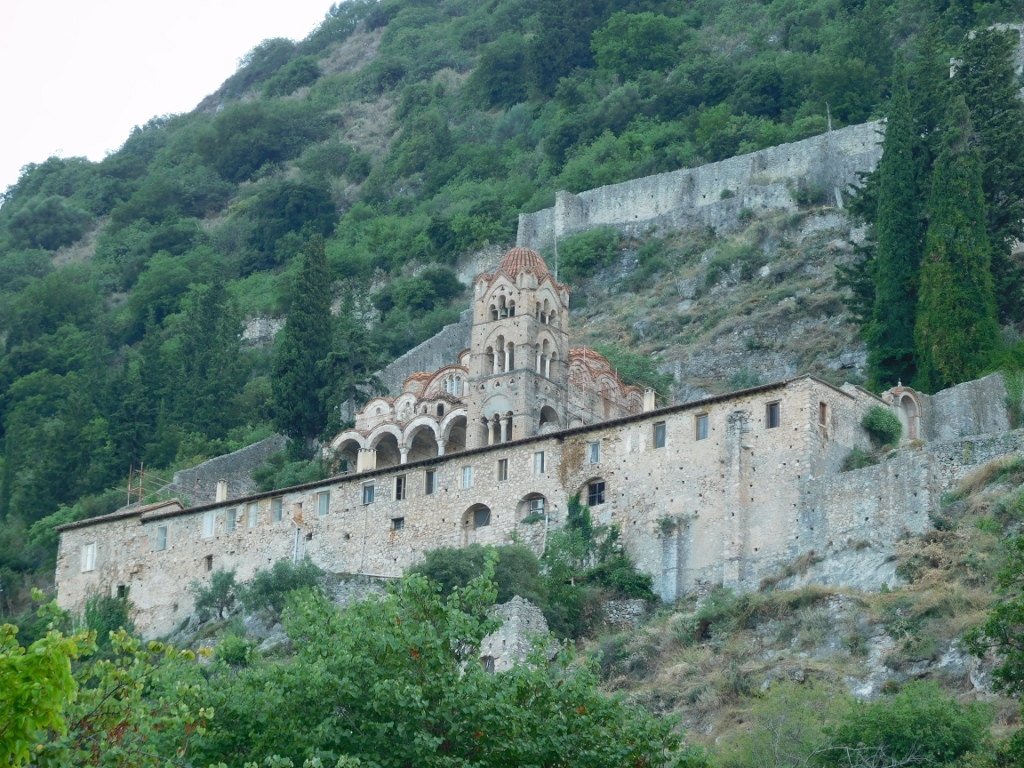 Archaeological Site of Mystras, a detail
Archaeological Site of Mystras, a detail
Then I could head toward the exit. Of course, I had to take one last selfie and after that, I made my way back to the car and returned to the modern village of Mystras.
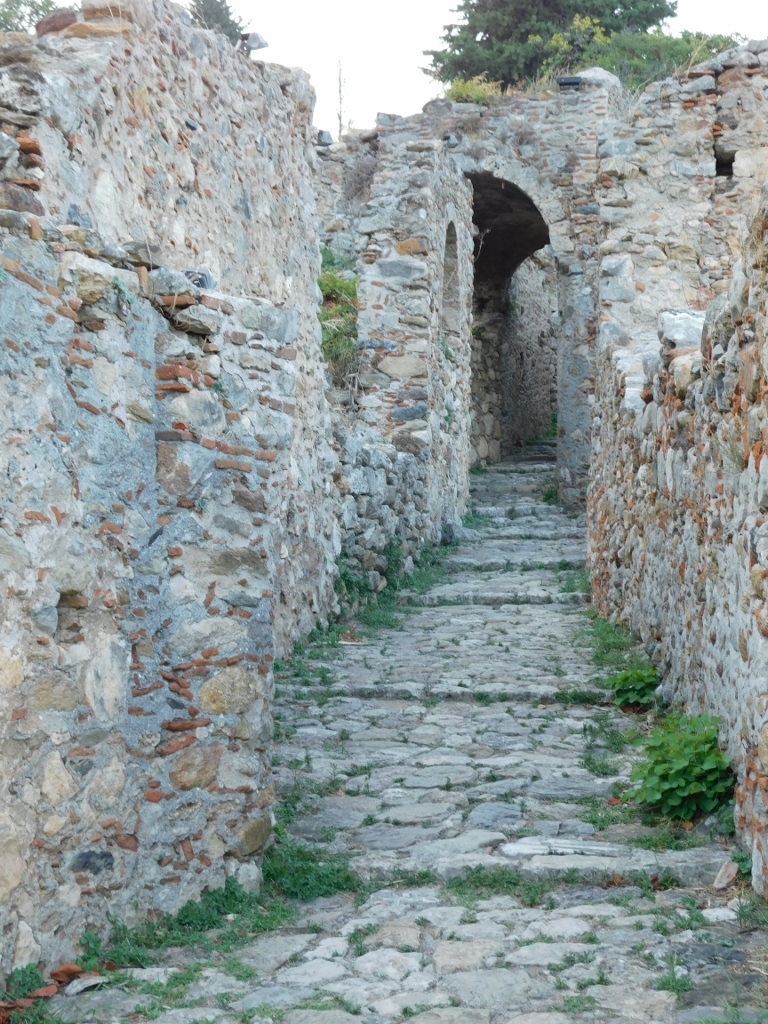 Archaeological Site of Mystras, a detail
Archaeological Site of Mystras, a detail
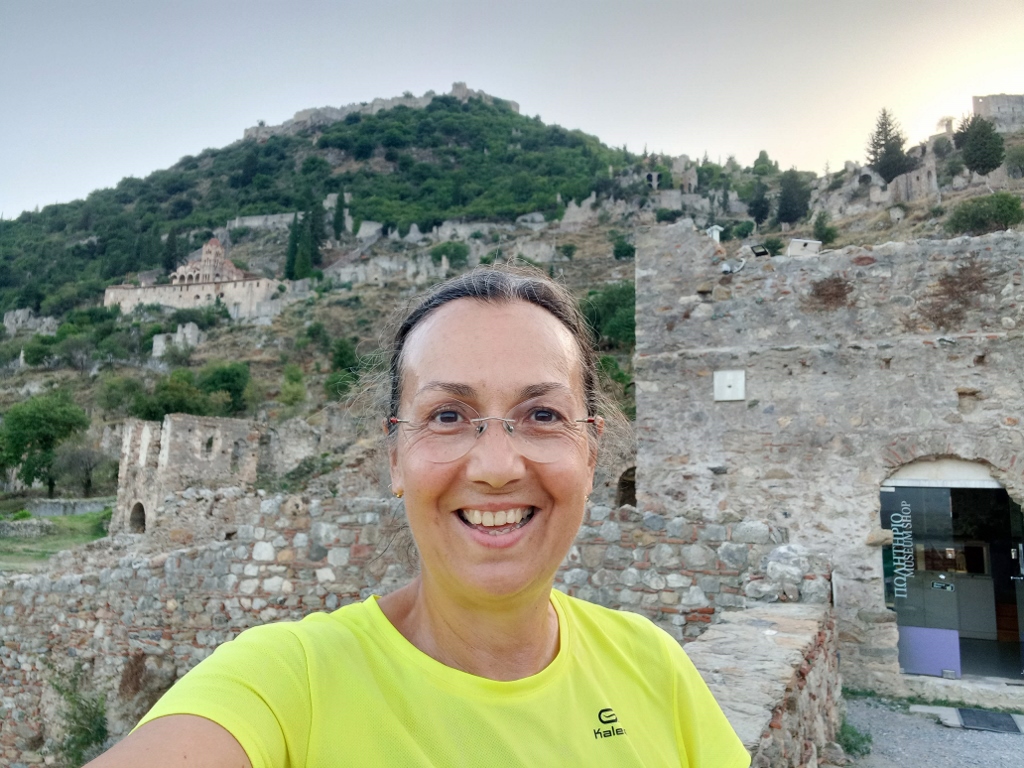 Selfie at the Archaeological Site of Mystras
Selfie at the Archaeological Site of Mystras
I first went to my room to take a shower since it had been quite hot all day and I had been sweating a lot. After that, I needed to focus on hydrating my body (for health reasons). Health always comes first!
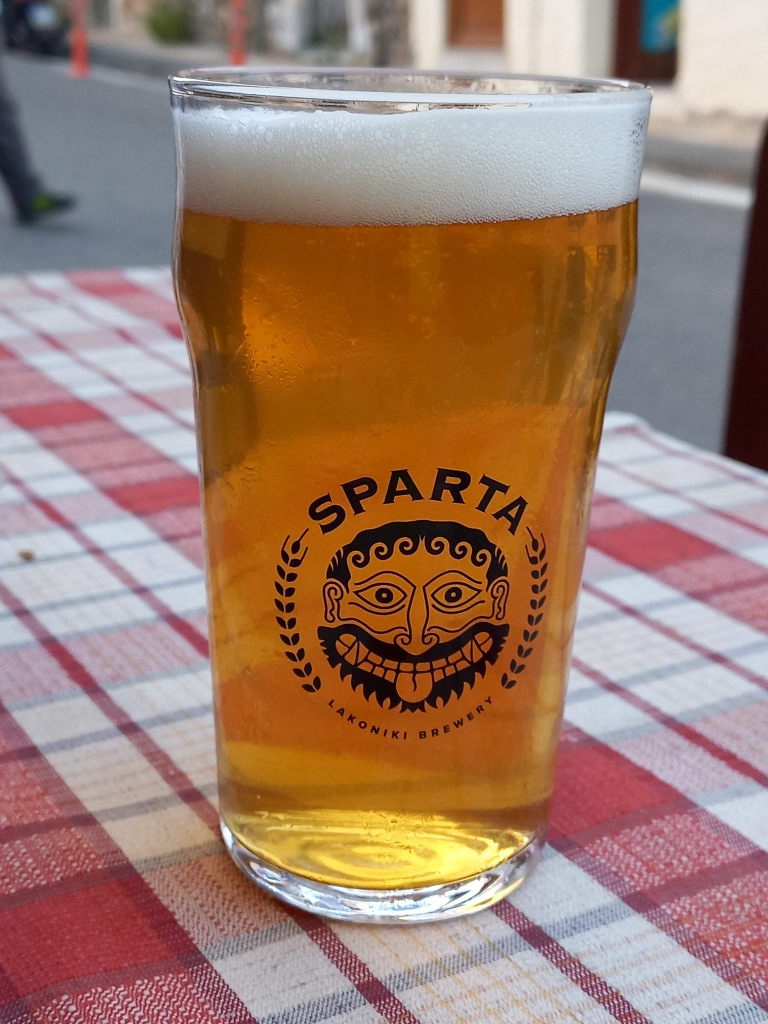 Hydration in Mystras
Hydration in Mystras
After the lovely relaxation in the centre of modern Mystras and as darkness began to fall, I took a little stroll through this charming and picturesque village.
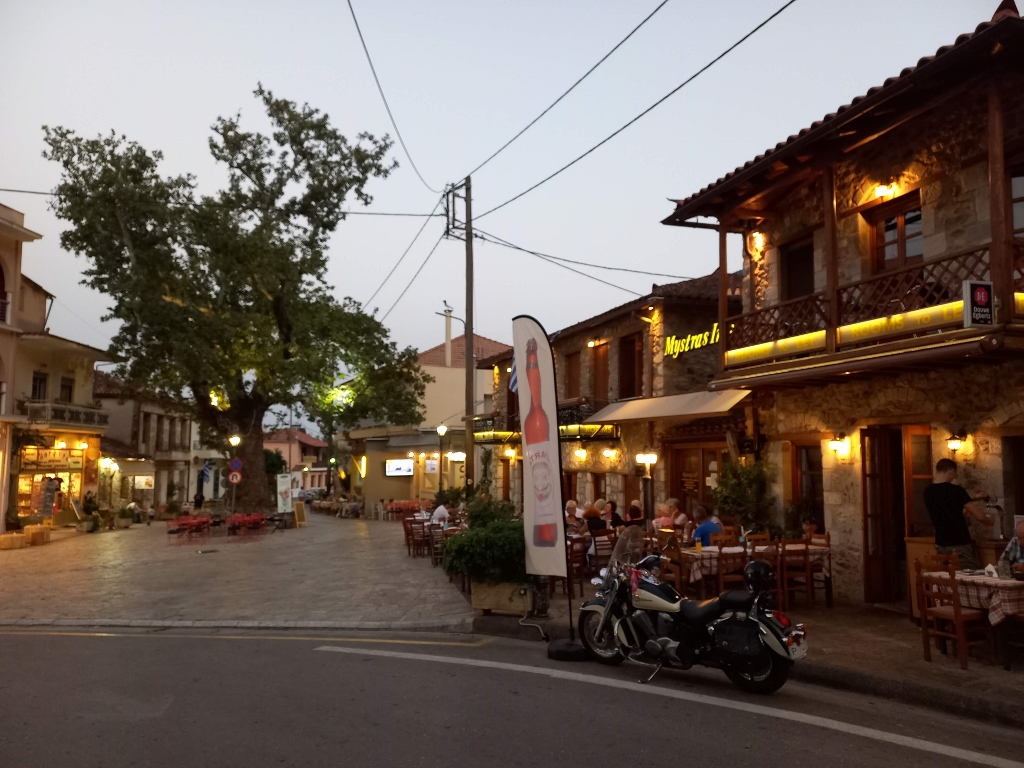 Contemporary Mystras
Contemporary Mystras
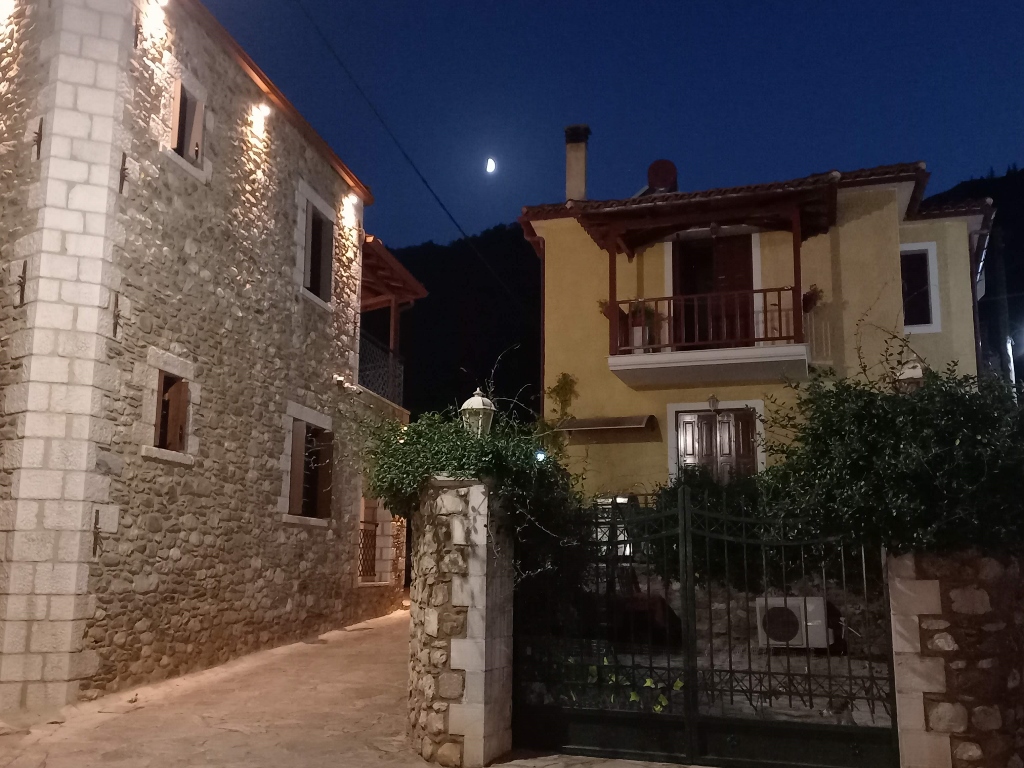 Contemporary Mystras
Contemporary Mystras
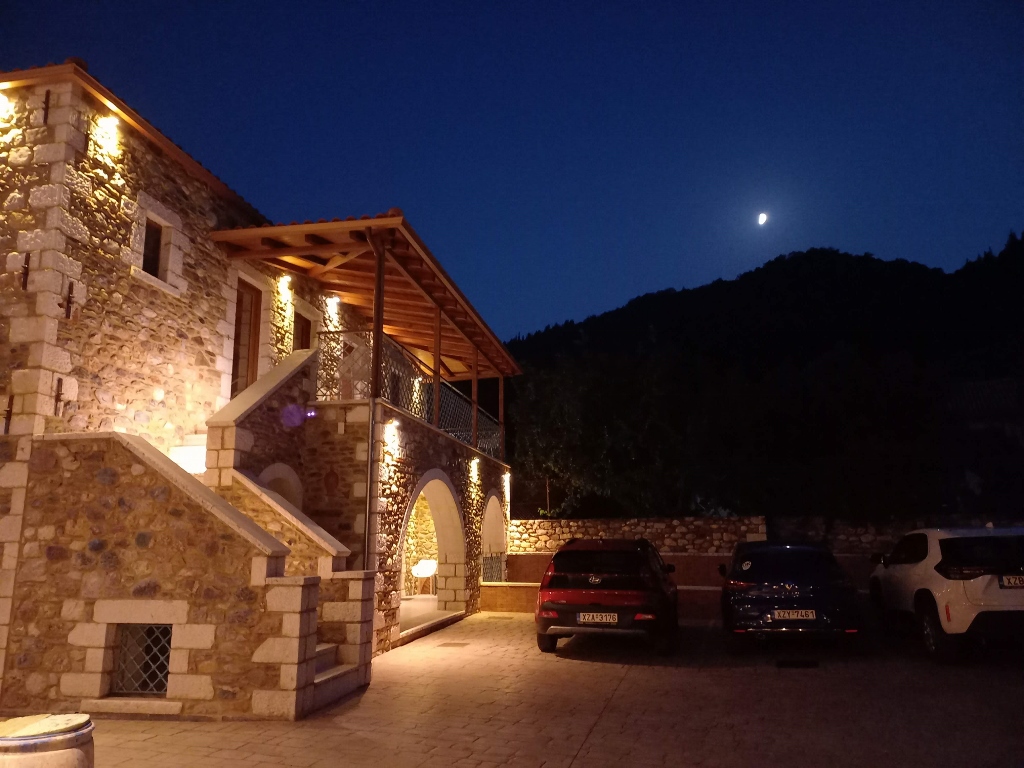 Contemporary Mystras
Contemporary Mystras
The following morning, I woke up quite early, but feeling wonderfully refreshed, so I immediately wanted to take some photos.
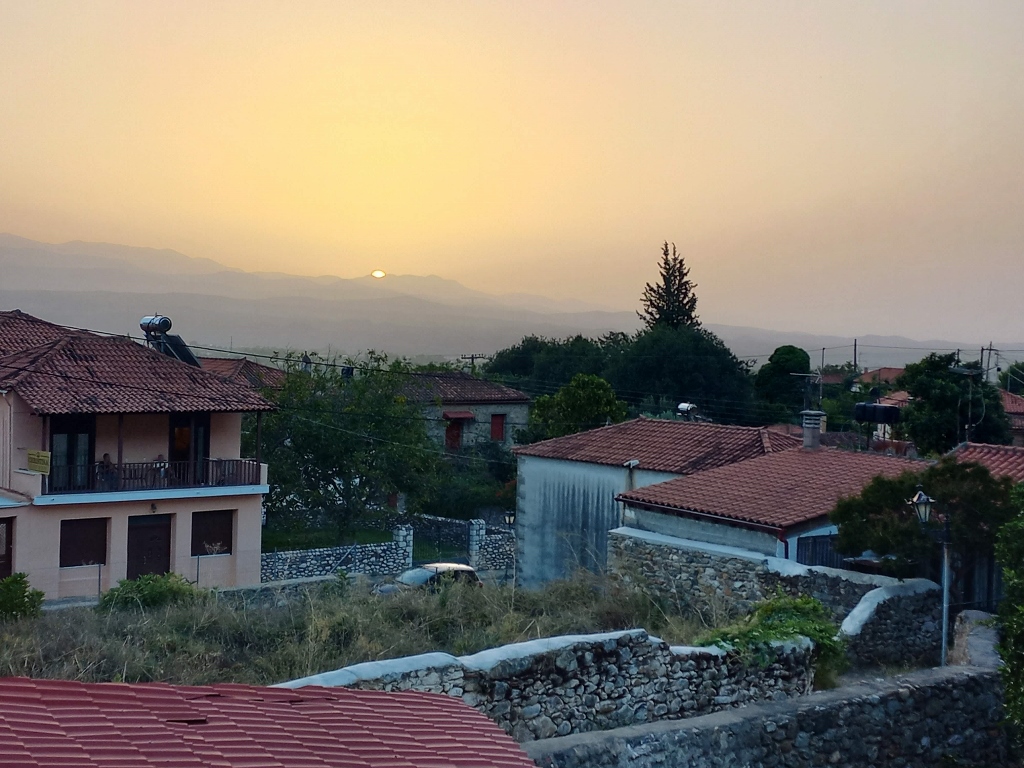 Room with a view in contemporary Mystras
Room with a view in contemporary Mystras
After breakfast and before continuing my journey, I took another photo from the terrace in front of my room, capturing the view of the impressive site of medieval Mystras. To avoid any confusion, it’s located on the elevation in the right part of the picture.
 View from contemporary Mystras at medieval Mystras
View from contemporary Mystras at medieval Mystras
On this day, I didn't have an overly ambitious plan; I only needed to travel for about 130 km. But that doesn’t mean the destinations weren’t interesting – on the contrary! Here’s a reminder of the places I visited during my stay in the Peloponnese and southern mainland Greece in September 2023.
So, on this day I first went to Sparta, drove through it and then continued south towards the middle "finger" of the Peloponnese known as the Mani Peninsula. Until relatively recently, the small villages along the shores of the Mani Peninsula could only be accessed by boat, but of course, roads have been built in more recent times. The peninsula, especially its western coast jutting into the Messenian Gulf, part of the Ionian Sea, is now quite popular as a tourist destination. However, its relative remoteness means that it doesn’t experience the same crowds found in other parts of Greece, especially in the summer.
I first headed to a very specific destination on the western coast of the peninsula, where I needed to descend to the beach. Before that, I took a shot of the area from above, where my route had led me to. Namely, the southern parts of the Taygetos mountain range stretch along the Mani Peninsula like a spine.
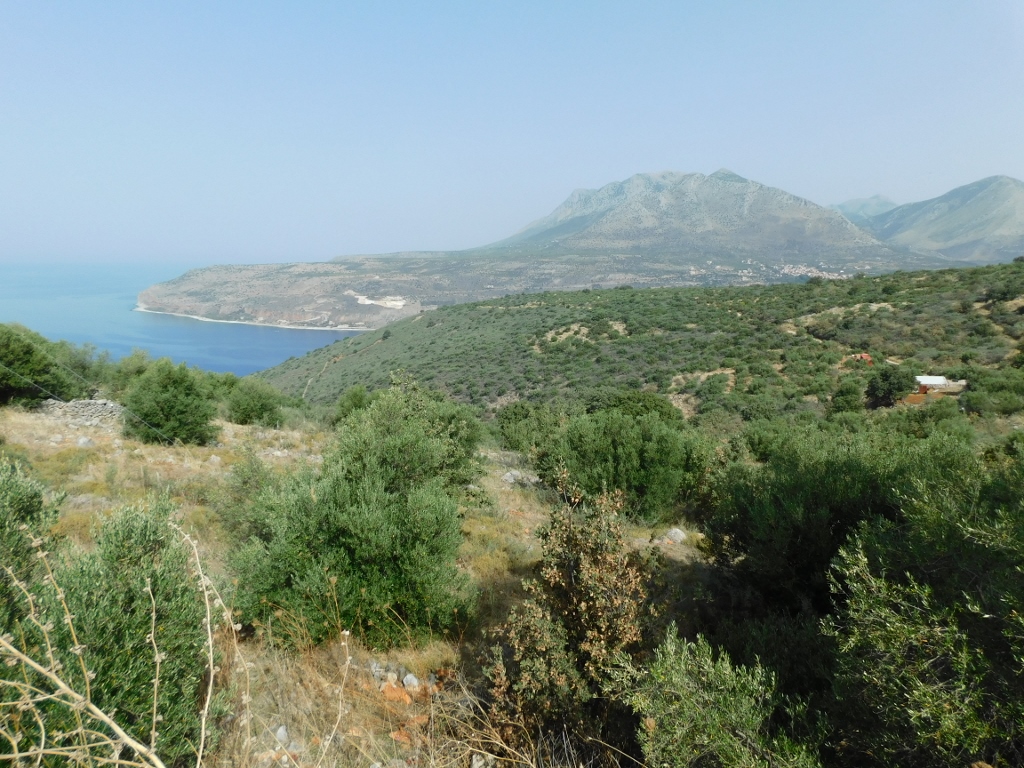 View at the western coast of the Mani peninsula
View at the western coast of the Mani peninsula
My goal here was to descend to the deep bay where Diros Beach is located, while on the southern side of the bay was my destination in this case – the impressive Diros Caves.
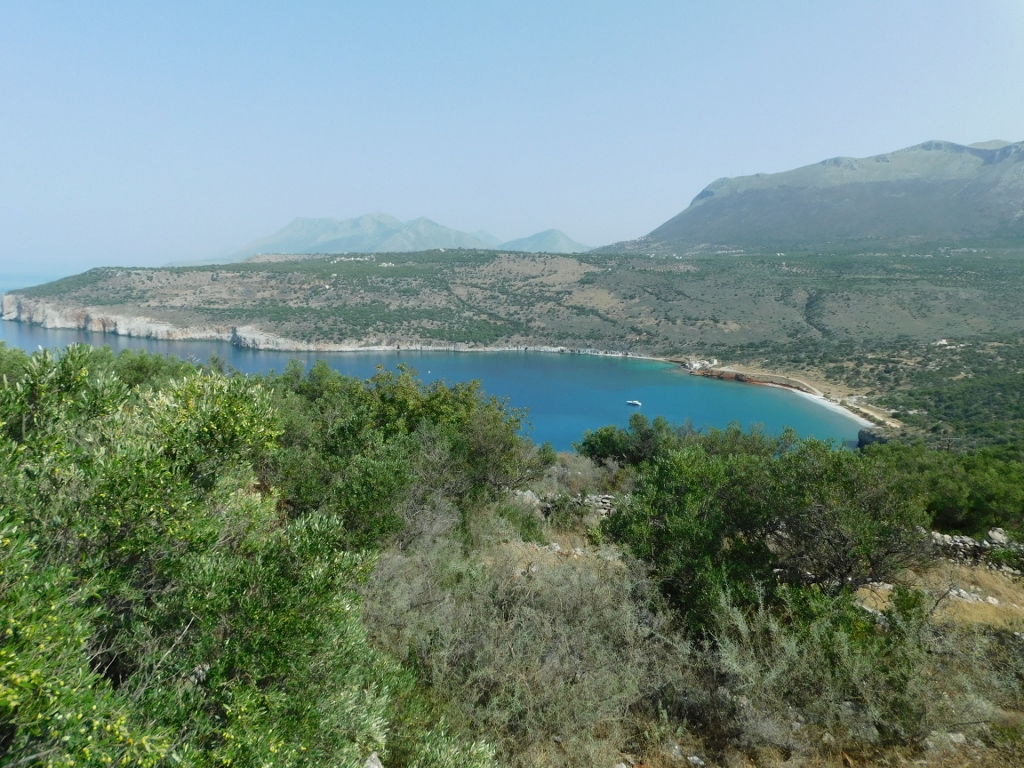 View at the Diros bay and beach
View at the Diros bay and beach
More specifically, I first drove to a parking area and found a free spot there, then I purchased my ticket and began my descent into the underground.
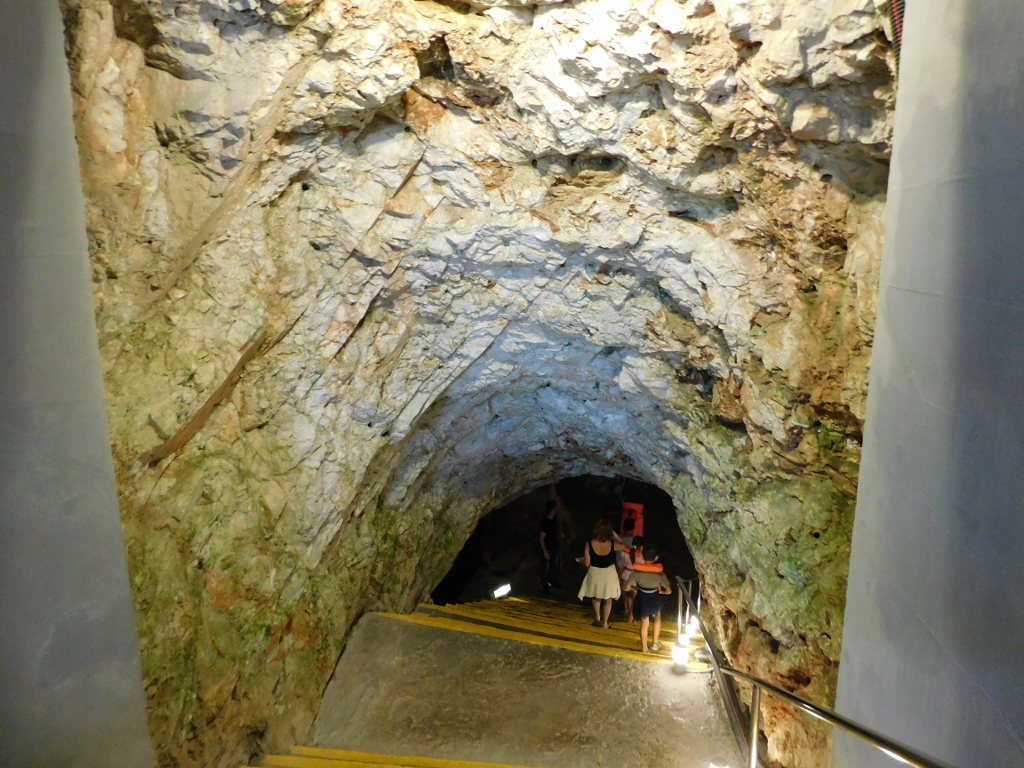 Entering the Diros Caves
Entering the Diros Caves